Aoostar WTR Pro NAS Review
The Aoostar WTR Pro NAS is a 4-bay hybrid storage system that enters the market with a combination of affordability and power, targeting both enthusiasts and prosumers alike. With configurations featuring either the AMD Ryzen 7 5825U processor or the Intel N100, this NAS offers a substantial amount of power for the price, coupled with flexible storage options through its M.2 SSD slots and SATA bays. Its design features unique side-mounted ports, a compact all-metal chassis, and ample ventilation to maintain optimal cooling during operation. While it brings a lot to the table, such as up to 32GB of memory, dual 2.5GbE ports, and high-powered USB-C connectivity, it also presents some compromises. The lack of 10GbE and USB4 connectivity limits its scalability, and while its internal performance is impressive, the absence of PCIe upgrade slots makes it a more restricted solution for users seeking long-term expansion.
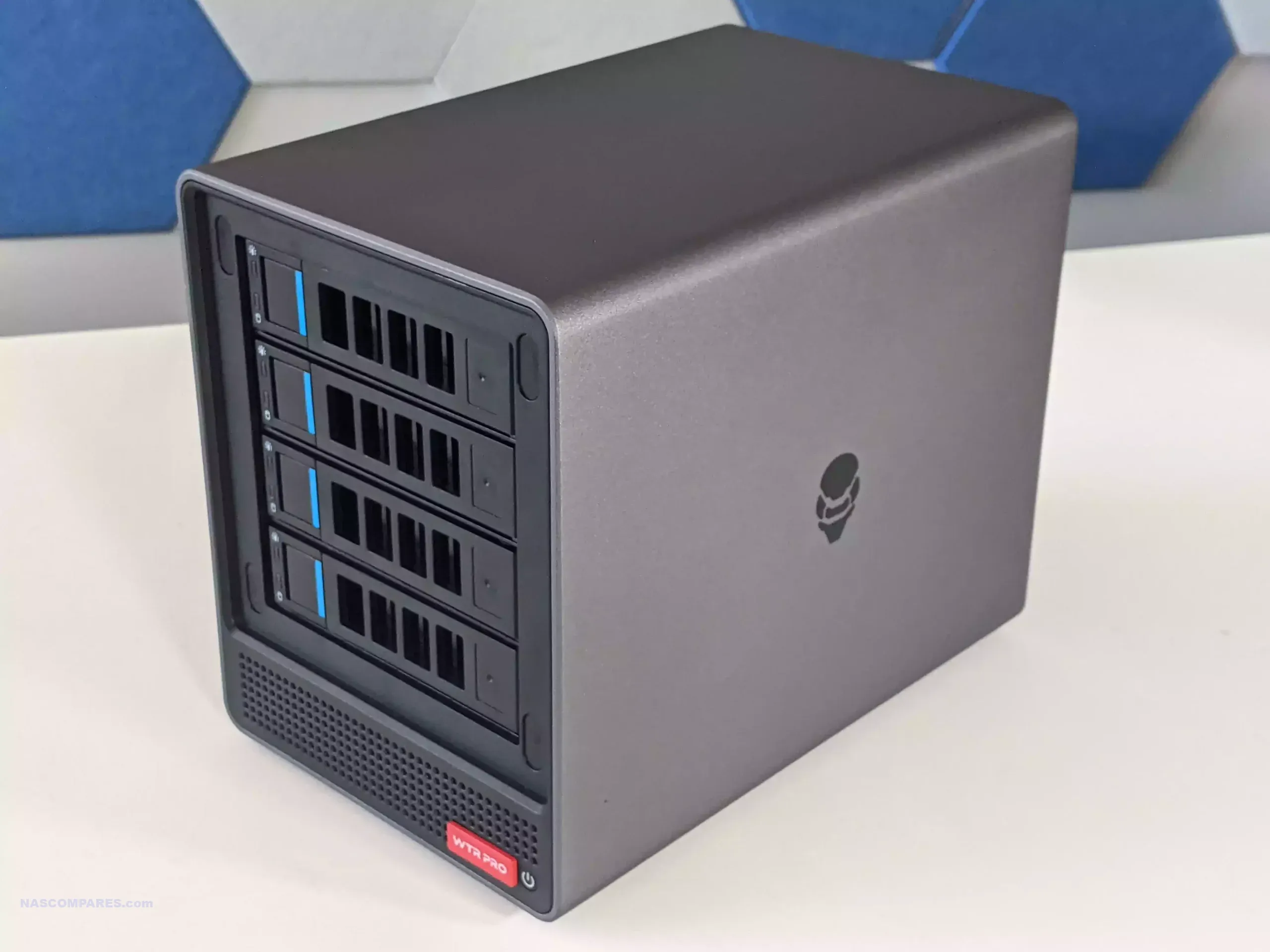
|
Where to Buy? Official Aoostar Shop – HERE AOOSTAR WTR PRO (Check Amazon) – HERE AOOSTAR WTR PRO (Check Aliexpress) – HERE |
Aoostar WTR Pro NAS Review – Quick Conclusion
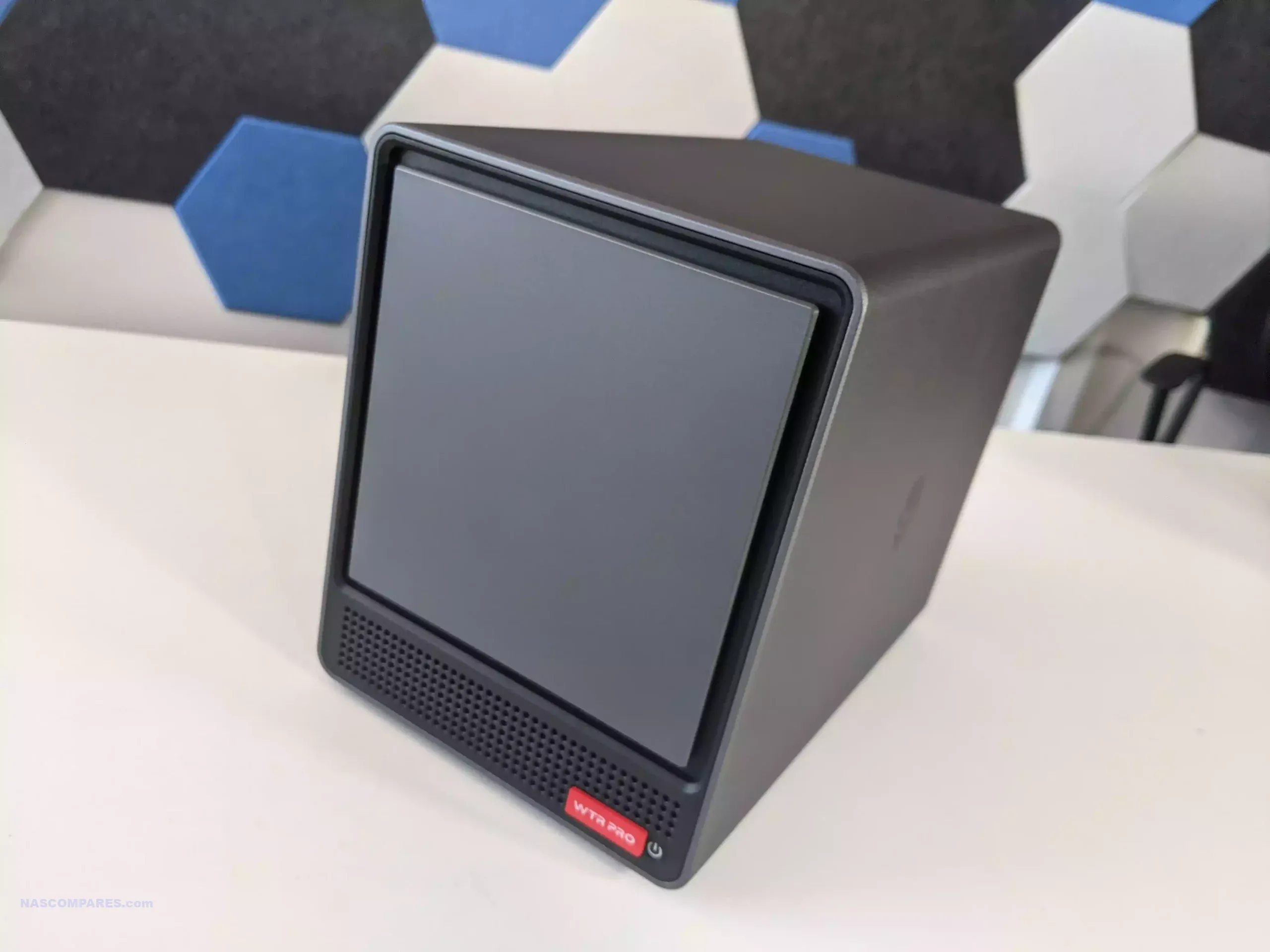
For under $499, the Aoostar WTR Pro NAS offers great value, with either an eight-core AMD Ryzen 7 system featuring 32GB of memory and a 512GB SSD, or a more affordable quad-core N100 version with 16GB of memory and a 128GB SSD starting at $349. This 4-bay M.2 SSD hybrid storage system competes well against other turnkey NAS solutions, although you’ll need to invest in a third-party operating system. The unique port placement on the chassis is a nice touch, and the two-slot configuration is something you don’t often see. However, there are compromises. The lack of 10GbE network connectivity and the absence of USB4 or OCuLink limits scalability, which may disappoint those wanting to maximize performance. While Aoostar has targeted more casual users with this system, making it less ideal for those seeking high scalability, it’s still a solid choice for enthusiasts and prosumers. Though not the most powerful solution they’ve released, it offers strong value for its price point.
Where to Buy a Product





![]()
![]()

VISIT RETAILER ➤






![]()
![]()

VISIT RETAILER ➤






![]()
![]()

VISIT RETAILER ➤






![]()
![]()

VISIT RETAILER ➤
 DEAL WATCH – Is It On Offer Right Now? DEAL WATCH – Is It On Offer Right Now?These Offers are Checked Daily
|
Aoostar WTR Pro NAS Review – Design
The accessory kit that the Aoostar WTR arrives with is all fairly standard stuff: Ethernet cable, mains power cable and PSU, first-time setup guide, screws for storage media, thermal pads—all the usual stuff.
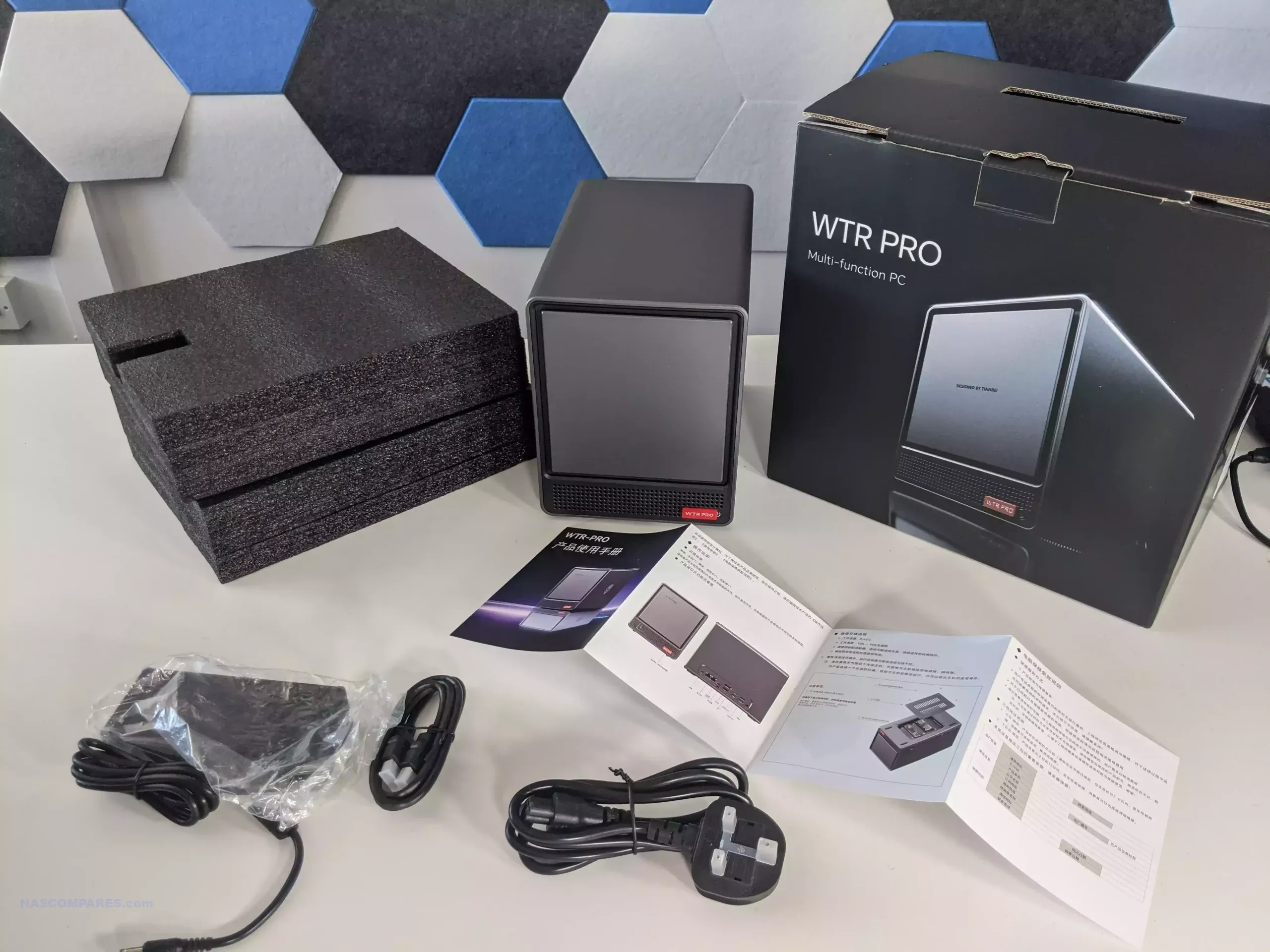
The external power brick is a fairly standard barrel two-part power supply, with a 120W rating. Aoostar already produces numerous other NAS solutions, and this is pretty much an identical PSU to what I’ve seen in all of the others.
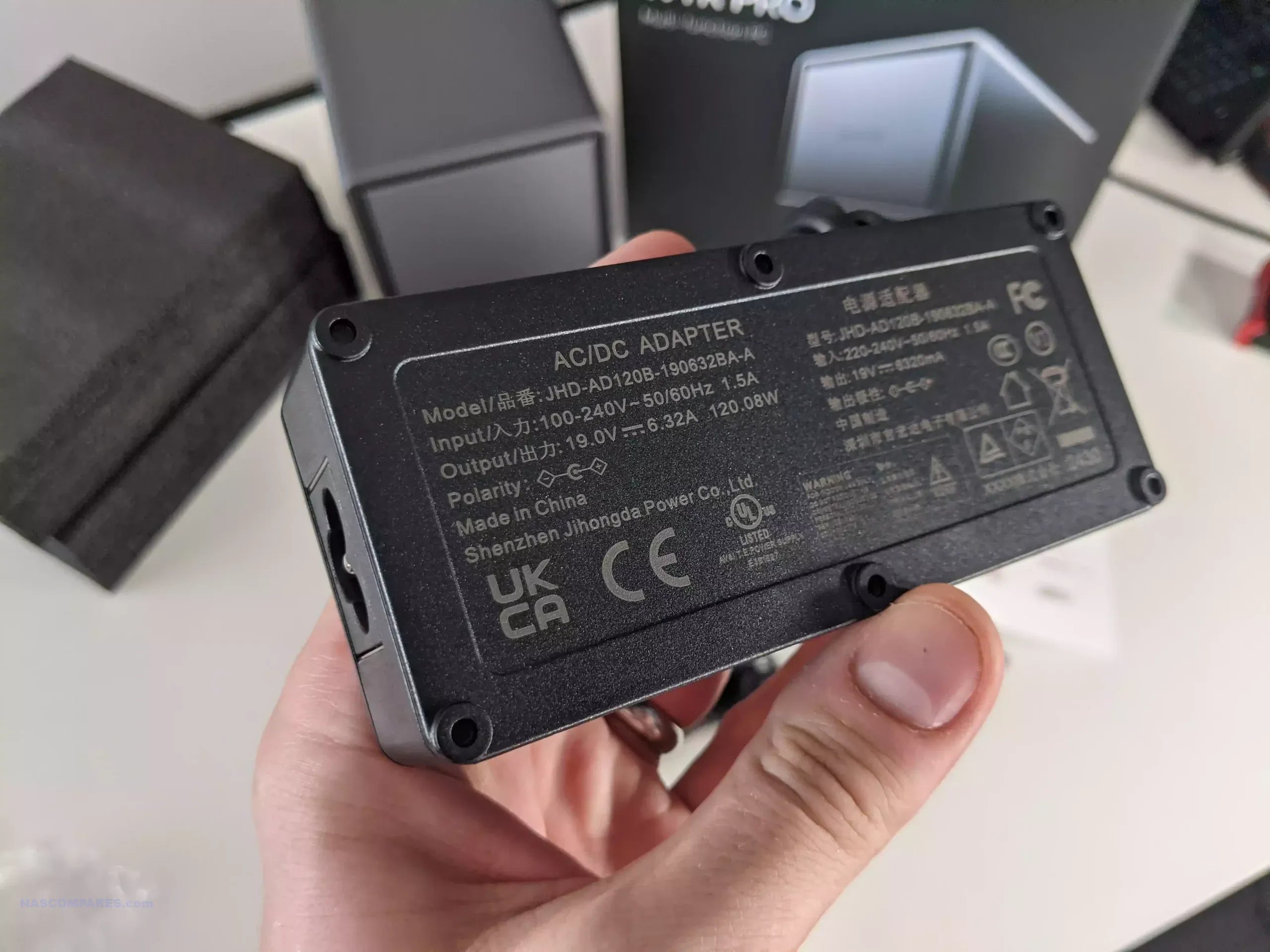
The external casing of the WTR is pretty robust, and although it looks fairly comparable to the majority of other cases in the market, it is completely metal on the exterior and is actually pretty compact compared with other 4-bay desktop chassis. A big part of this is due to the rather unique placement of ports, but we’ll get to that later on.

The front panel features a little bit of ventilation along the base, a removable front panel, and a pretty unique sliding power button protector. This isn’t exactly rocket science, but I will say that it’s actually surprisingly unusual for a desktop NAS to provide a small cover to prevent accidental pressing of the power button. It’s a small thing, but it’s weird that this is one of the first times I’ve seen it in 2024!
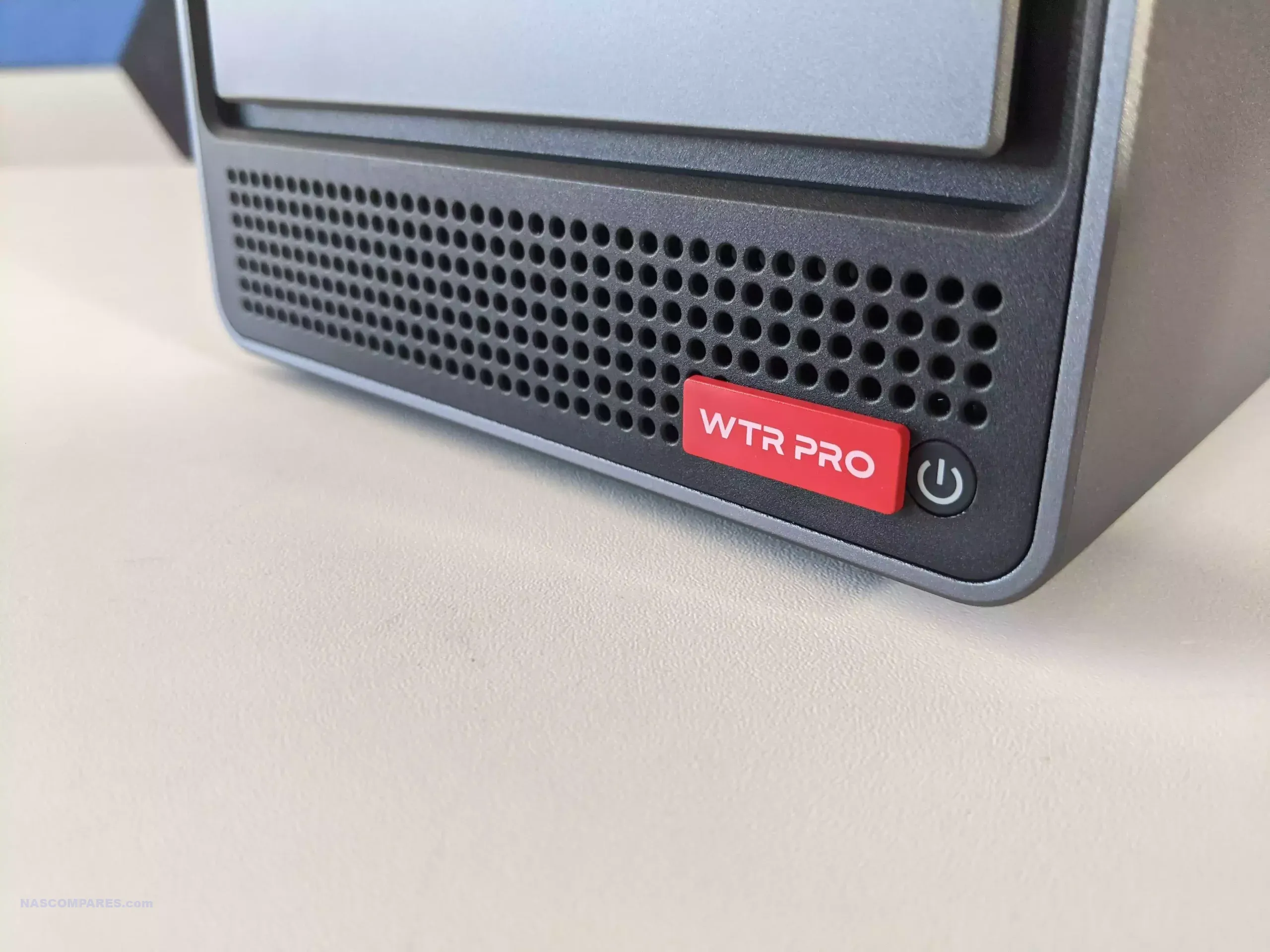
The ventilation panel at the base of the system actually lives underneath the main SATA storage cage, and it’s in direct alignment with the internal combined heatsink and fan attached to the CPU. This vent is pretty critical in maintaining the cool operation of the CPU when the system is in use. Once again, it’s actually surprisingly unusual to find a ventilation panel like this on the front of a NAS, as this space is almost always occupied by the main storage bays or perhaps a modest LCD screen. Cooling has definitely been something that Aoostar has kept an eye on during this system’s development.
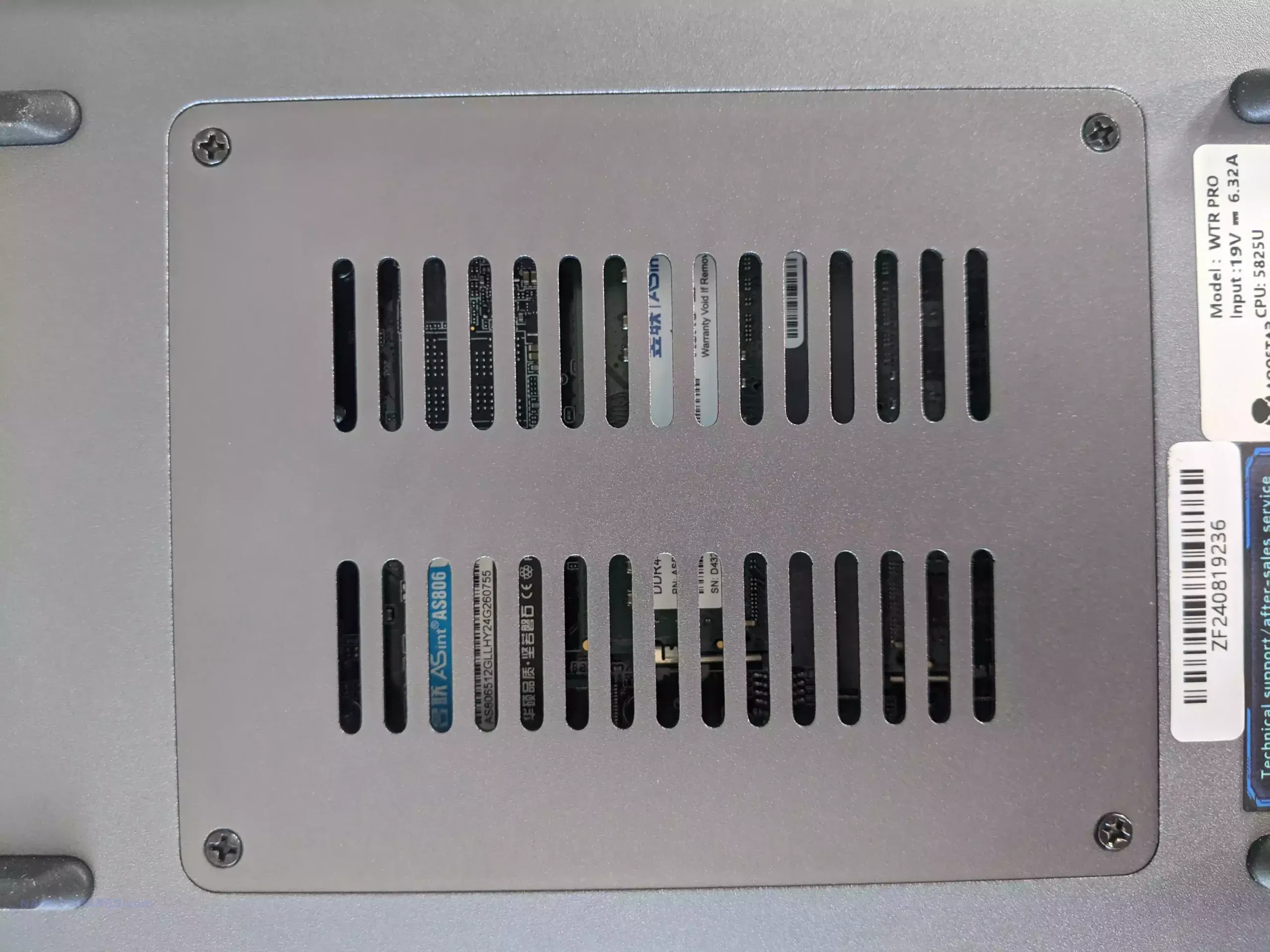
Turning the system around, we find one large rear-mounted active cooling fan that feeds directly behind the main storage cage as well as into the main motherboard PCB area. Notice something missing yet?
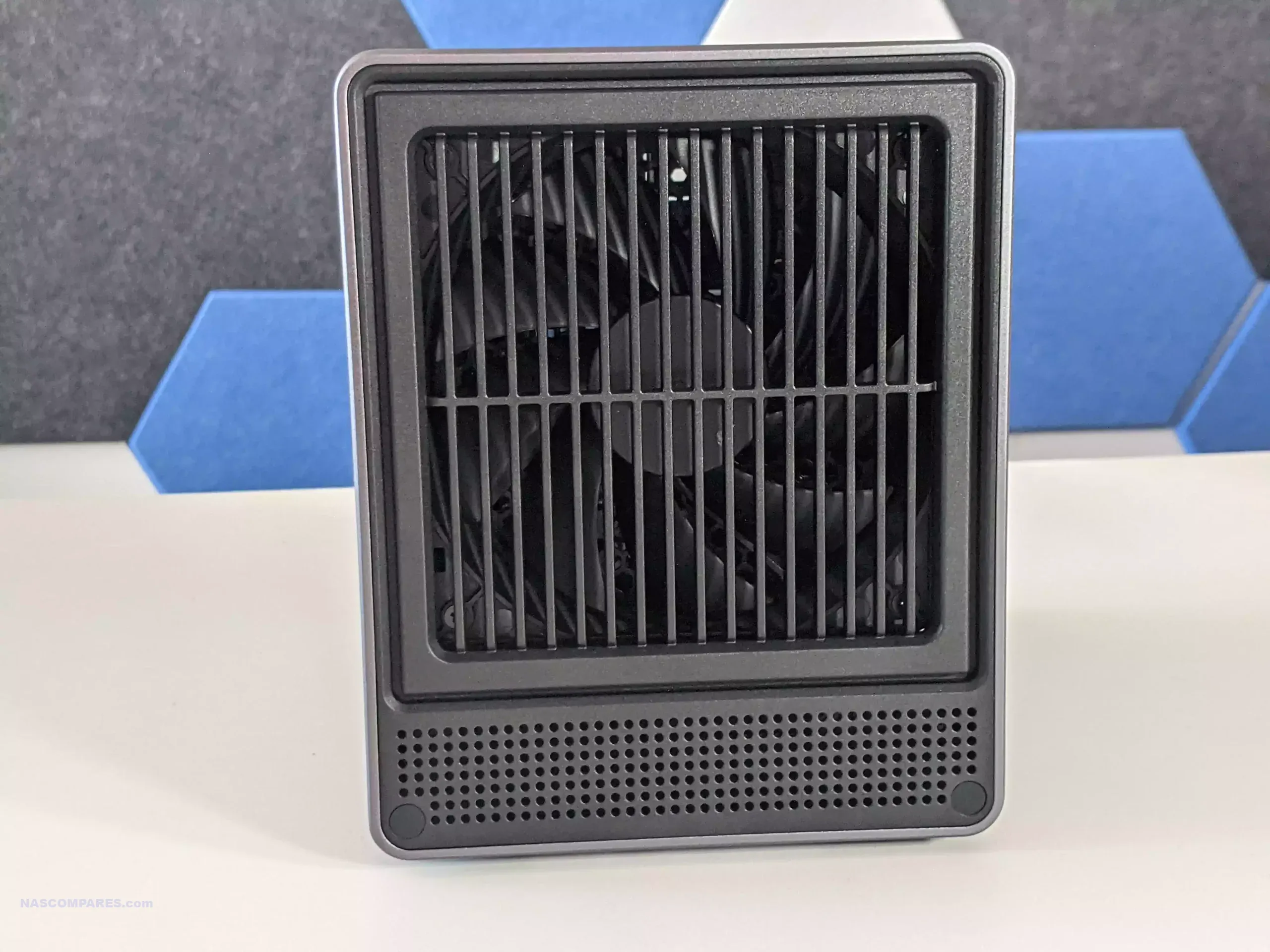
When the system was idle, noise levels of this fan and the drives only reached around 31 to 32 dBA. When the CPU was at 50% use and all four hard drives and the two M.2 SSDs were in active use, the system peaked at around 39 to 41 dBA when in operation.
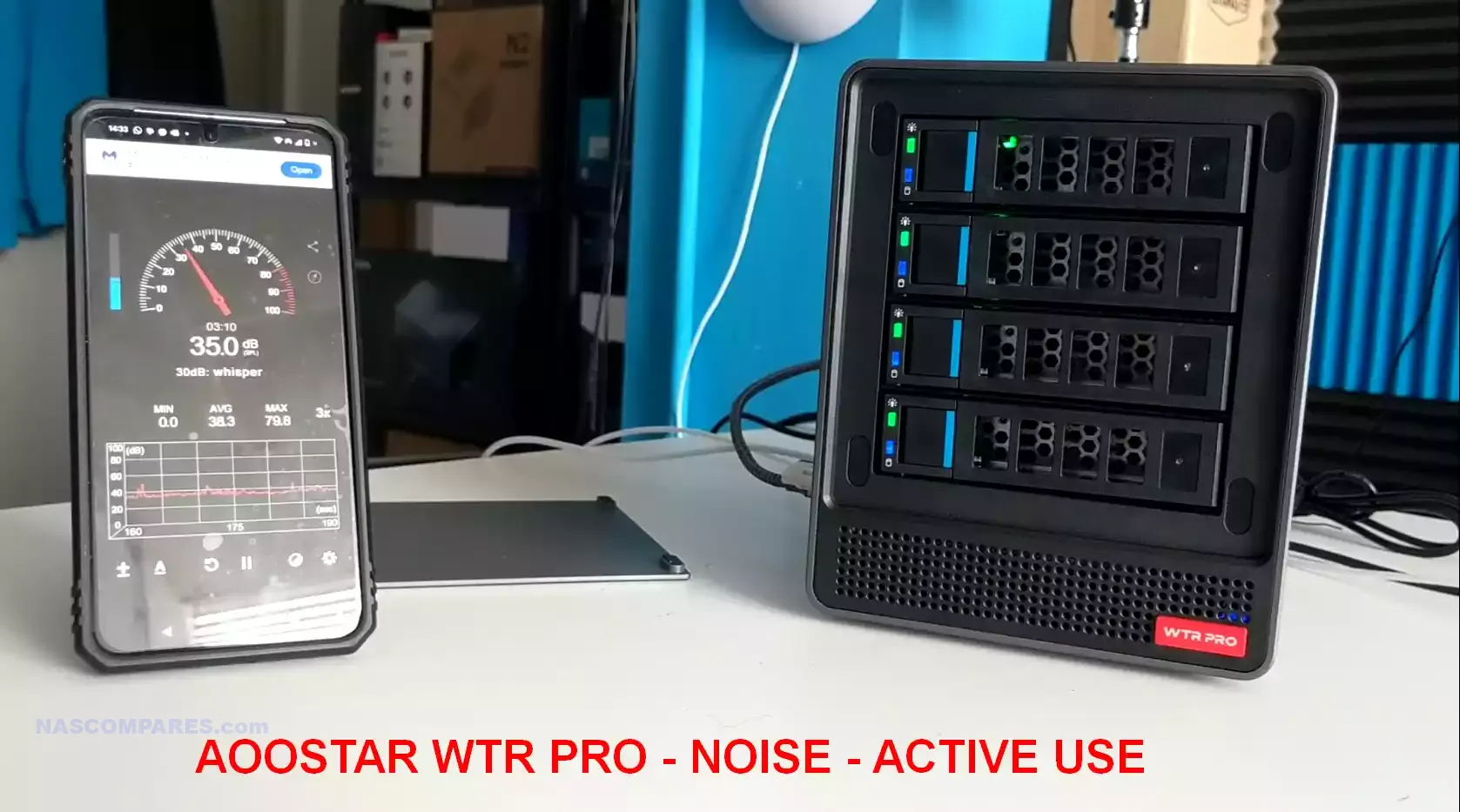
The main storage area is located behind a magnetic removable front metal panel. This is very easy to remove and has no locking mechanism. The individual storage bays are all in spring-loaded hard drive trays. Once again, there is no locking mechanism. Each hard SATA bay features LEDs for power and access.
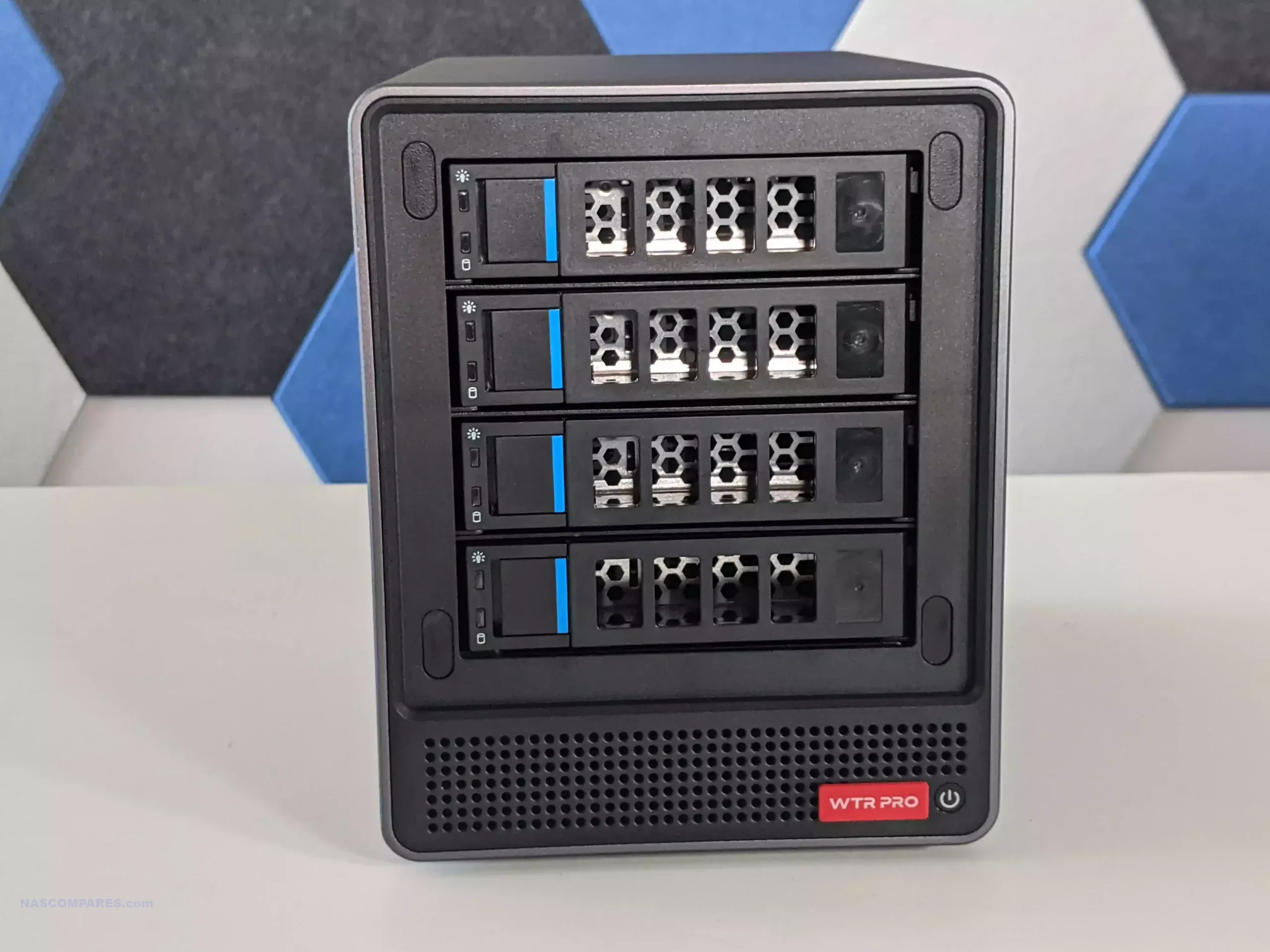
Each removable tray is a metallic, click-and-load hard drive tray. However, I’m not a big fan of these trays. Really! 3.5-inch hard drives will slot into the individual grooves to hold each drive in place, and there is even a flippable extension lever at the top to allow longer drives or those that require more adapters, but they really do feel cheap! Trying to get a hard drive out of these trays is incredibly difficult and is not the simple ejection process that most click-and-load trays have. You could very easily damage a drive trying to remove it from these trays. Not really a deal breaker, but definitely something I observed during testing.
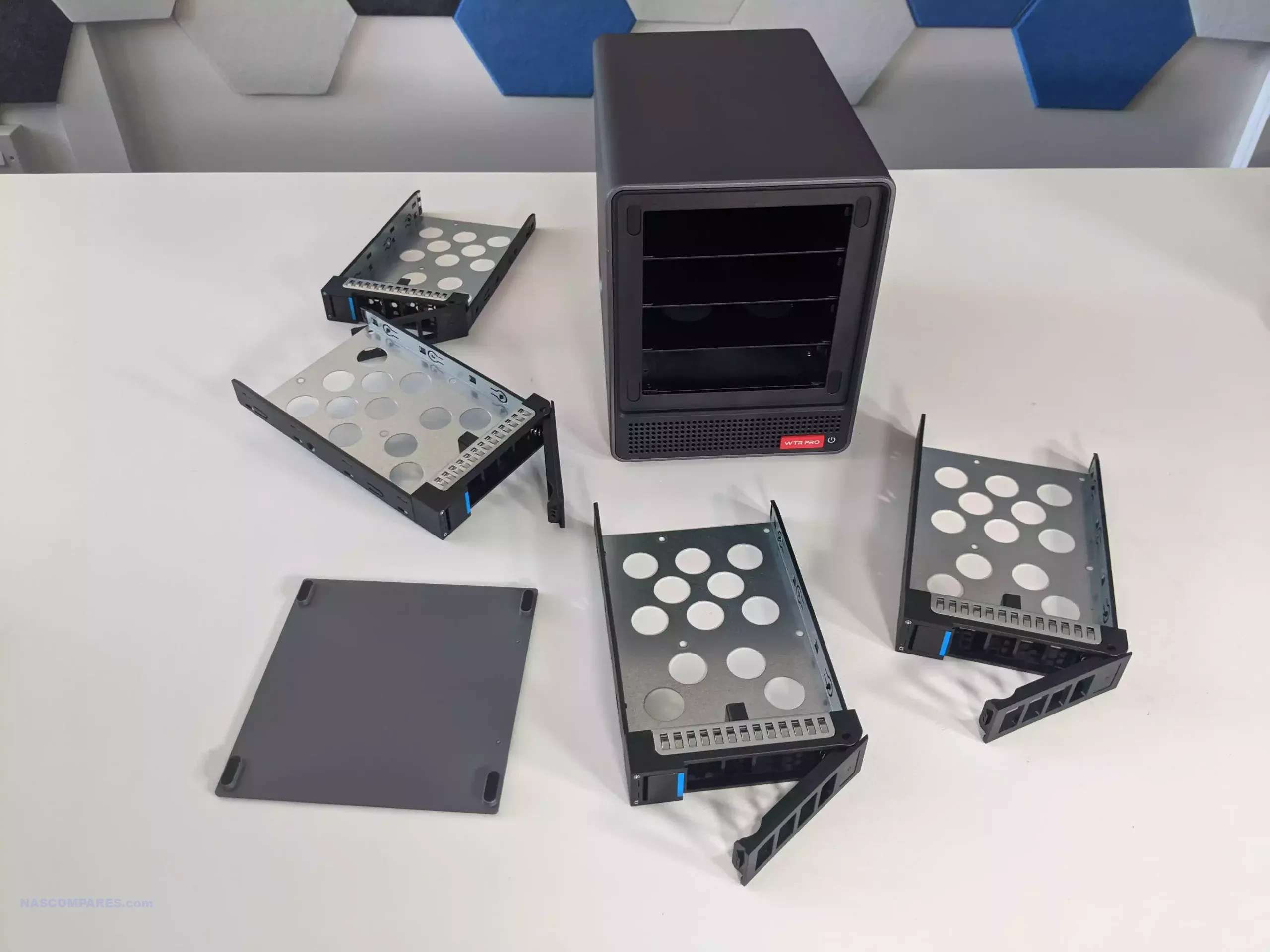
Removing each of the individual trays shows a clean, internal, separate metal cage that guides each drive. It’s a nice, clean setup that directly backs onto the active cooling system featured on the WTR.
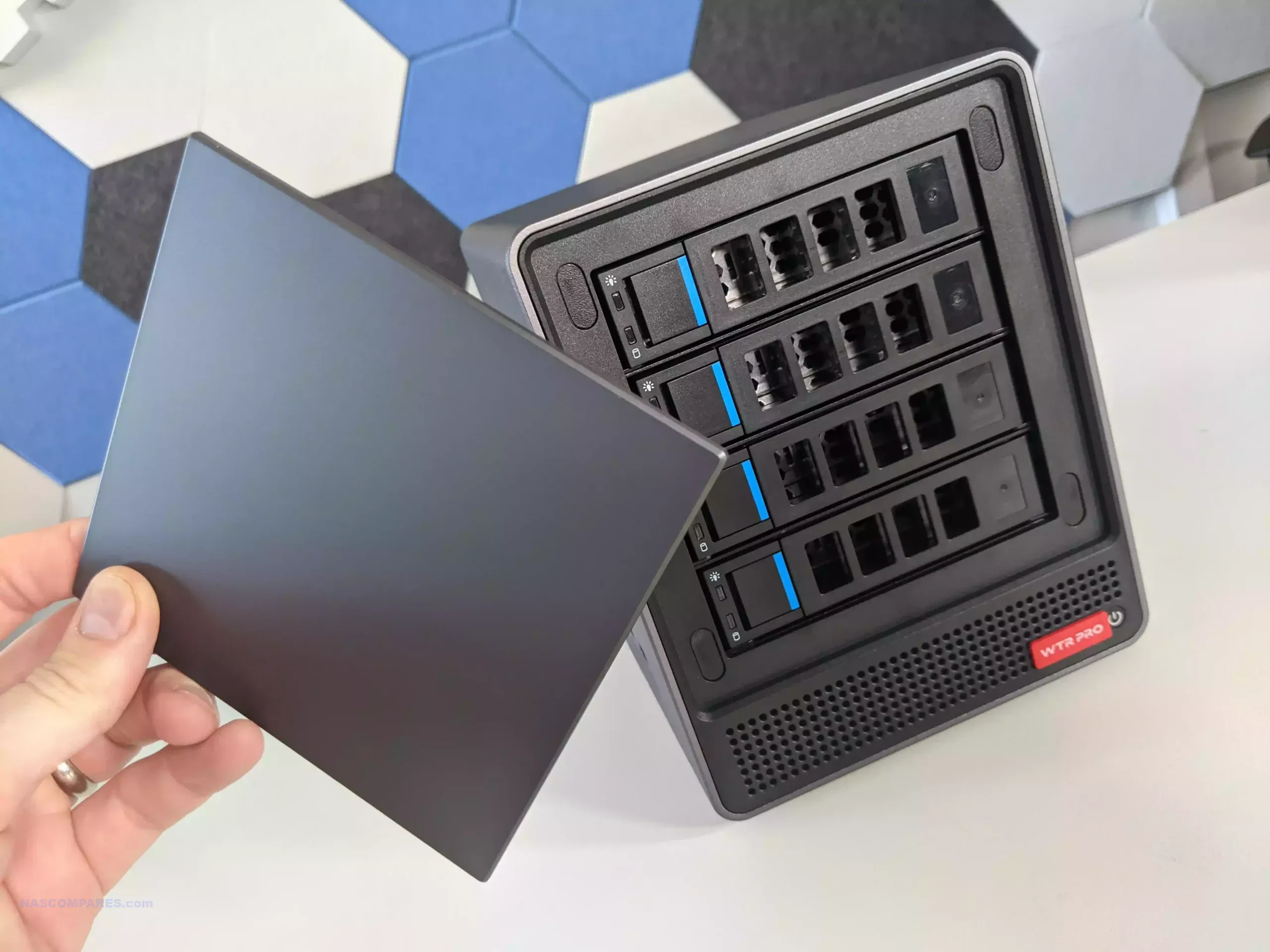
Remember earlier when I wondered where the ports were? Well, they’re located on the side of the chassis. Unlike the majority of other NAS and computer systems that feature the ports and connections on the rear or front of the device, Aoostar has opted for all of the connections on the WTR Pro to be located on the side. It’s an unusual choice, likely due to the use of a micro-ITX board internally. This custom build ensures the chassis is more compact, but once I started utilizing these ports on the side of the chassis, they made a lot more sense.
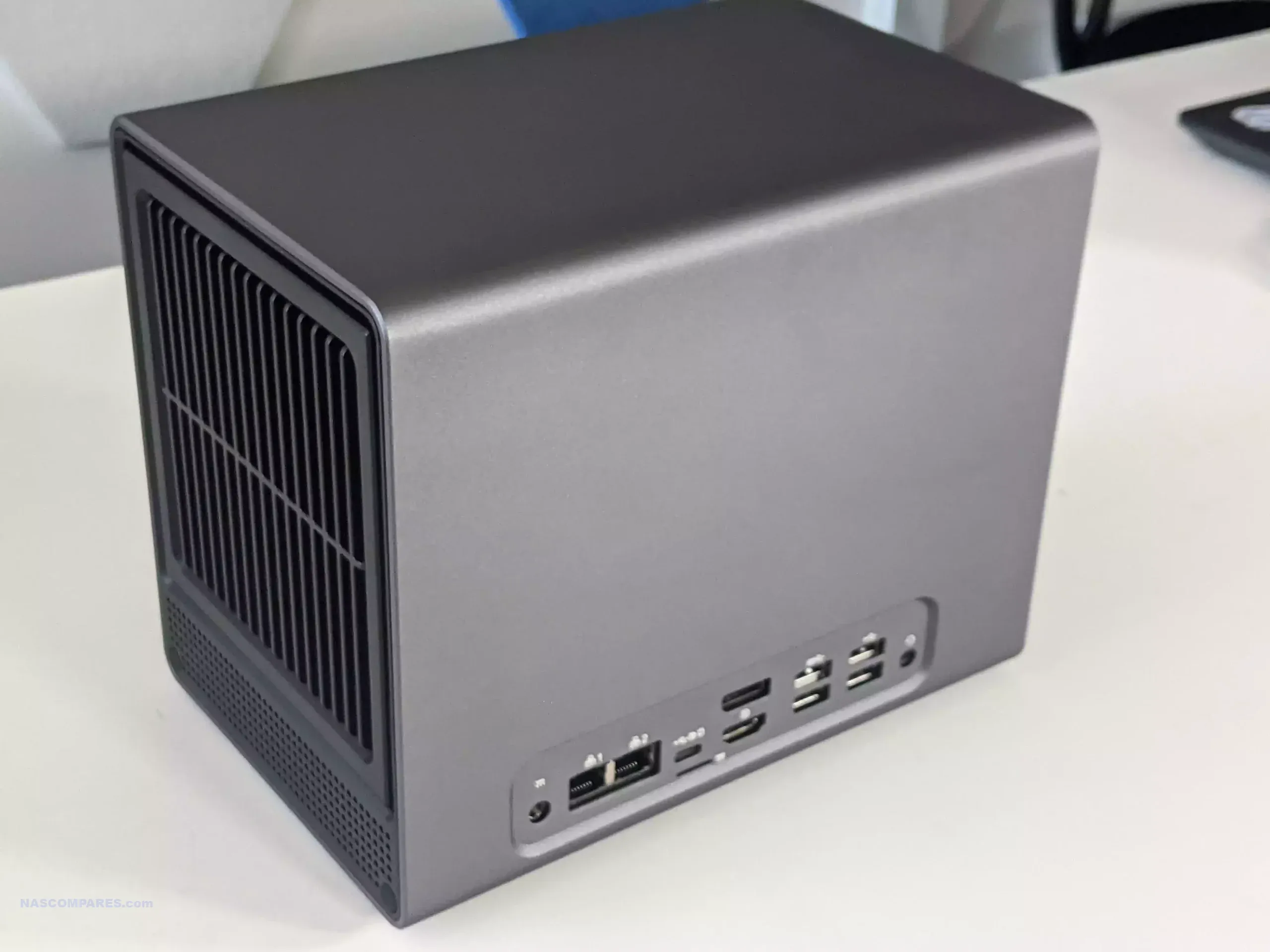
The ports and connections on the side meant that I could place the NAS in a way that took up considerably less space on my desk, unlike systems with front-facing ports where space behind the system is wasted for cables. Having the ports and connections on the side starts to make sense when you start using it, as the system results in less desk wastage. The ports are also more usable at the same time. Again, it’s not reinventing the wheel here, but I do quite like this little quirky detail.
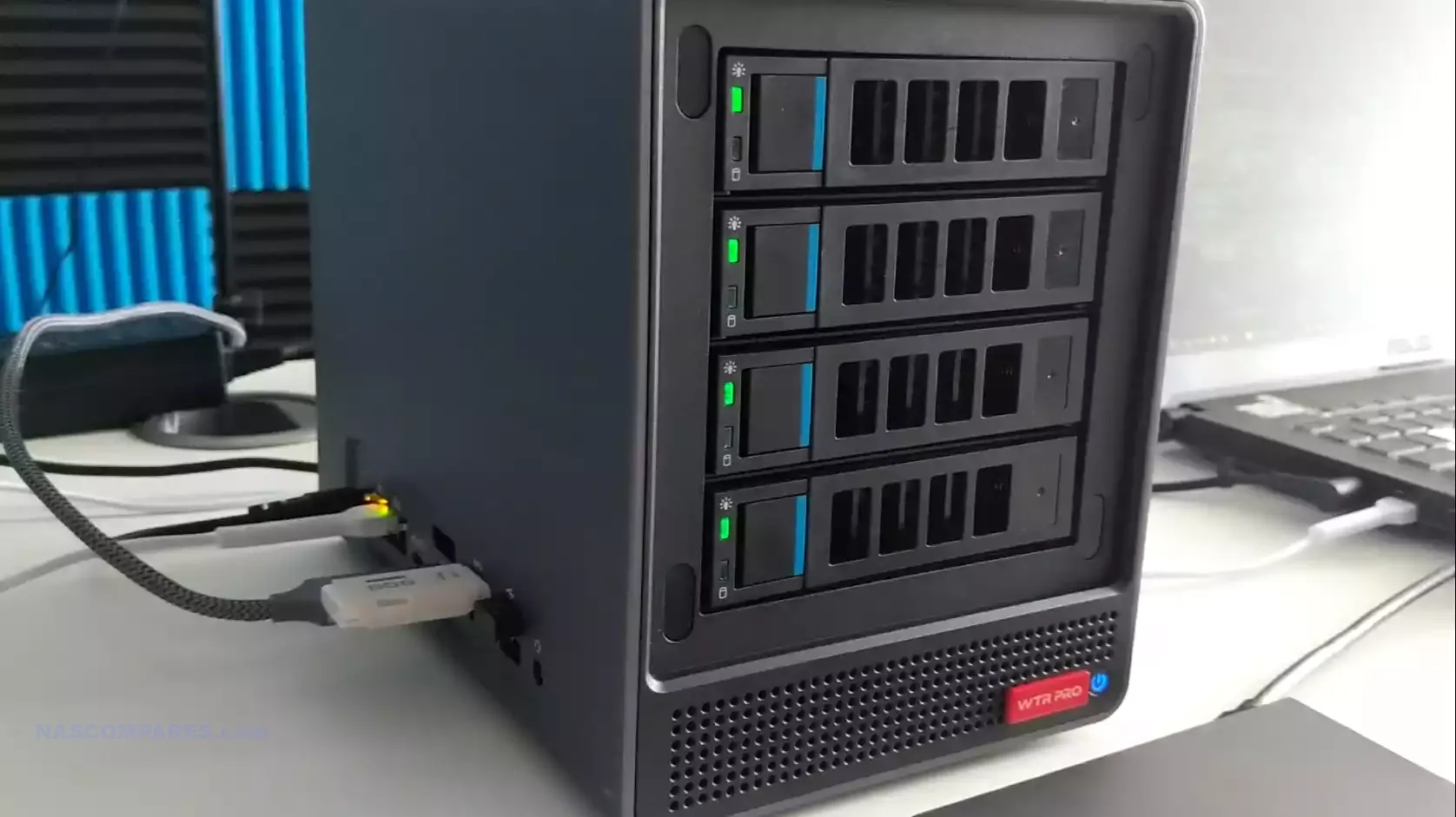
Aoostar WTR Pro NAS Review – Ports and Connections
Given that this system arrives with a fairly beefy AMD Ryzen processor with 20 lanes to play with, I’m actually kind of surprised at the range of ports and connections featured on the Aoostar WTR Pro. For a start, there is a complete lack of default 10GbE here. There is also a complete lack of USB4. Both of these are weirdly absent on a system that is quite powerful, and although USB adapters have arrived on the market to allow greater network and storage connections, the lack of even a PCIe upgrade slot is somewhat puzzling here.
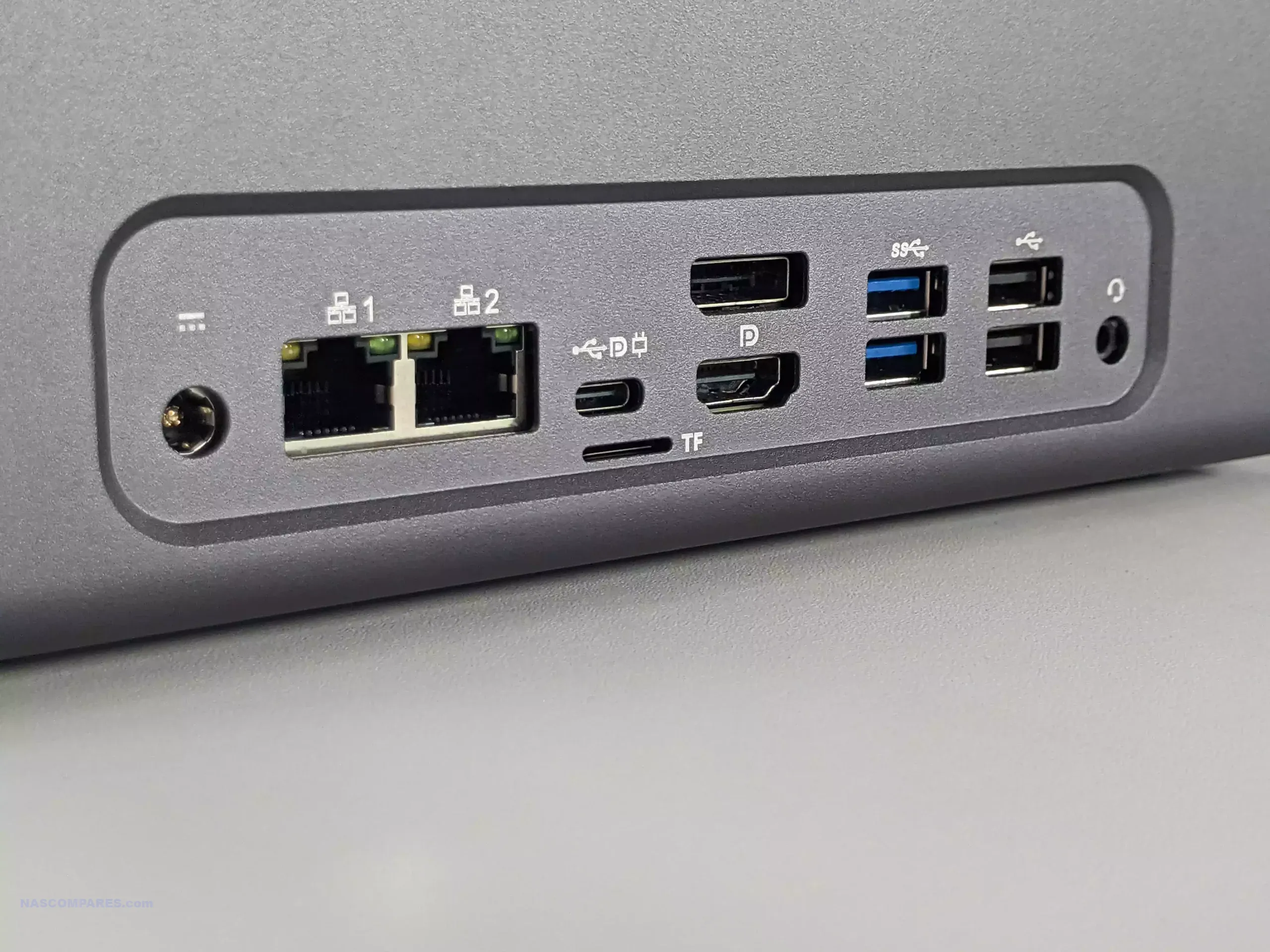
The default network connections on the WTR Pro are 2.5GbE, with two individual ports to be precise. Each one can obviously be fully saturated up to 279 MB per second, and there is support for failover depending on the operating system you choose to use. But given this system arrives with two Gen 3 x4 M.2 NVMe slots and four SATA hard drive bays that support numerous RAID configurations, this really does present something of an external bottleneck on the WTR NAS. Again, it’s sorely missing a 10GbE connection.
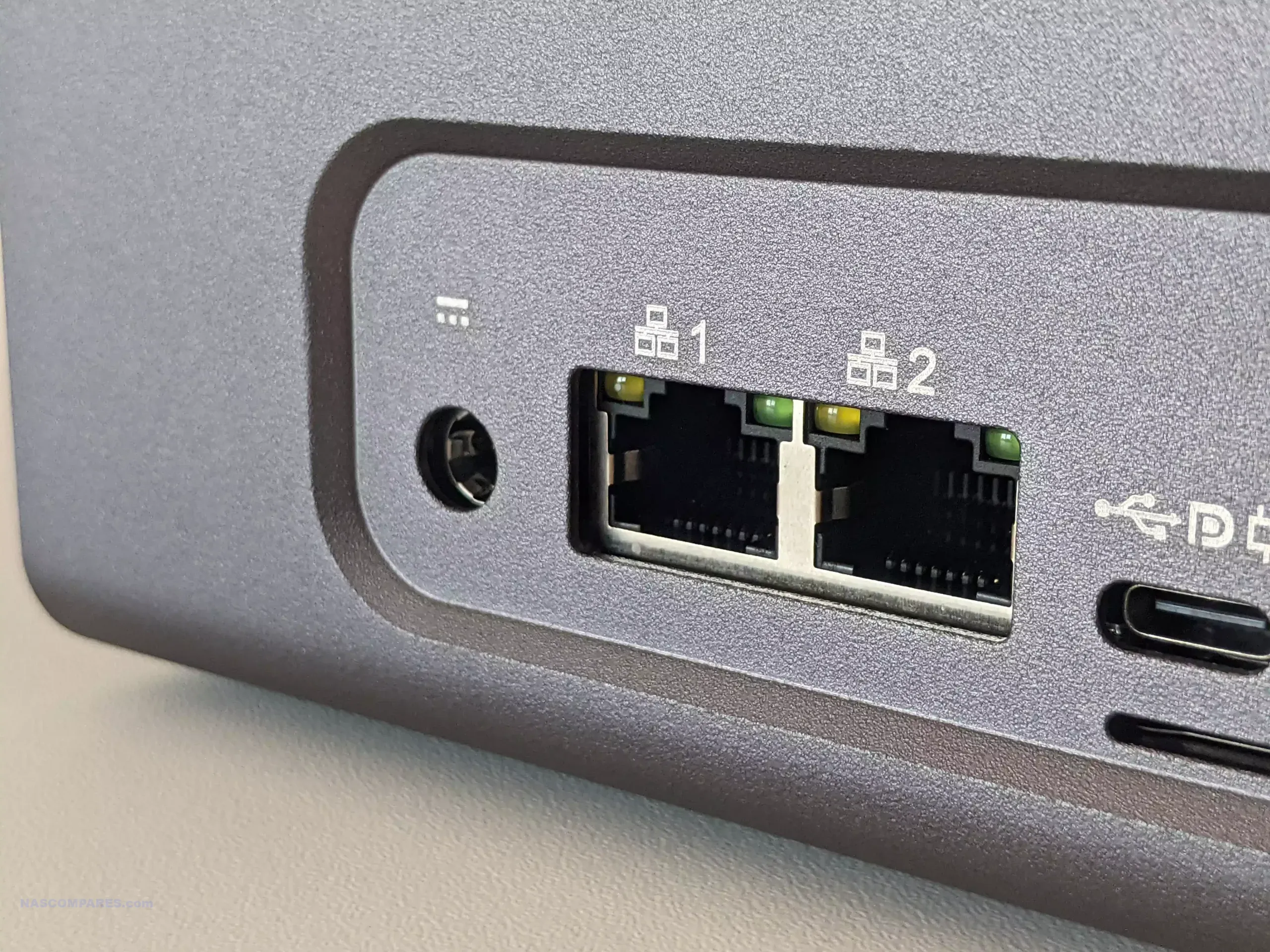
The system does feature a MicroSD slot on the rear, which can be used for casual backups or even to boot some NAS operating systems from, if needed. I’ve seen a few NAS systems arrive recently with full SD and higher-class SD card slots, so although it’s useful to have this MicroSD slot, it’s actually a bit underwhelming compared with current NAS releases.
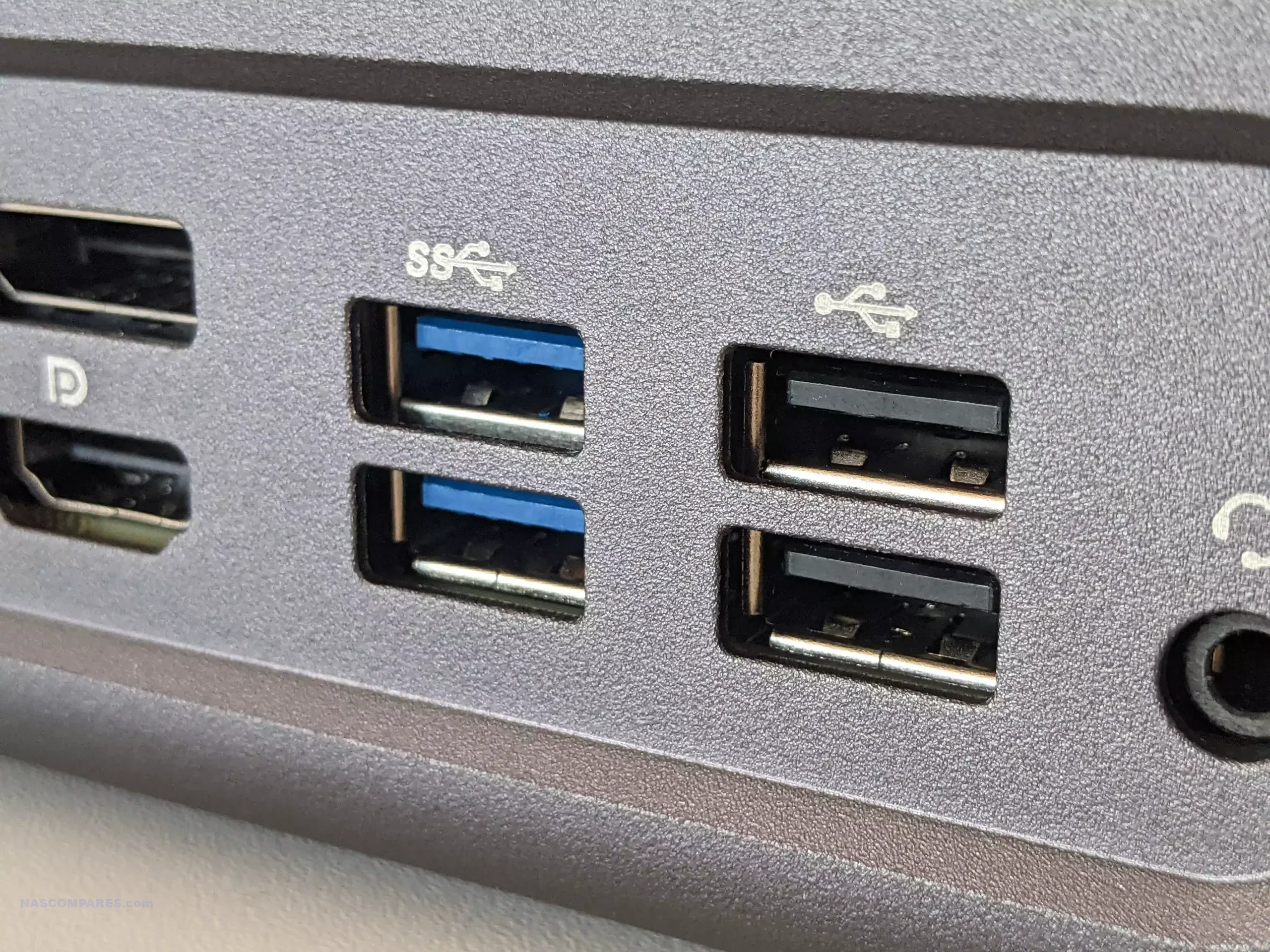
There is a wide variety of USB ports featured on the system, with two USB 3.2 ports, two USB 2.0 ports, and a USB-C connection as well. The USB-C connection is a high-powered 100W power delivery port and can also be used as a display output alongside the other two visual outputs on the system.
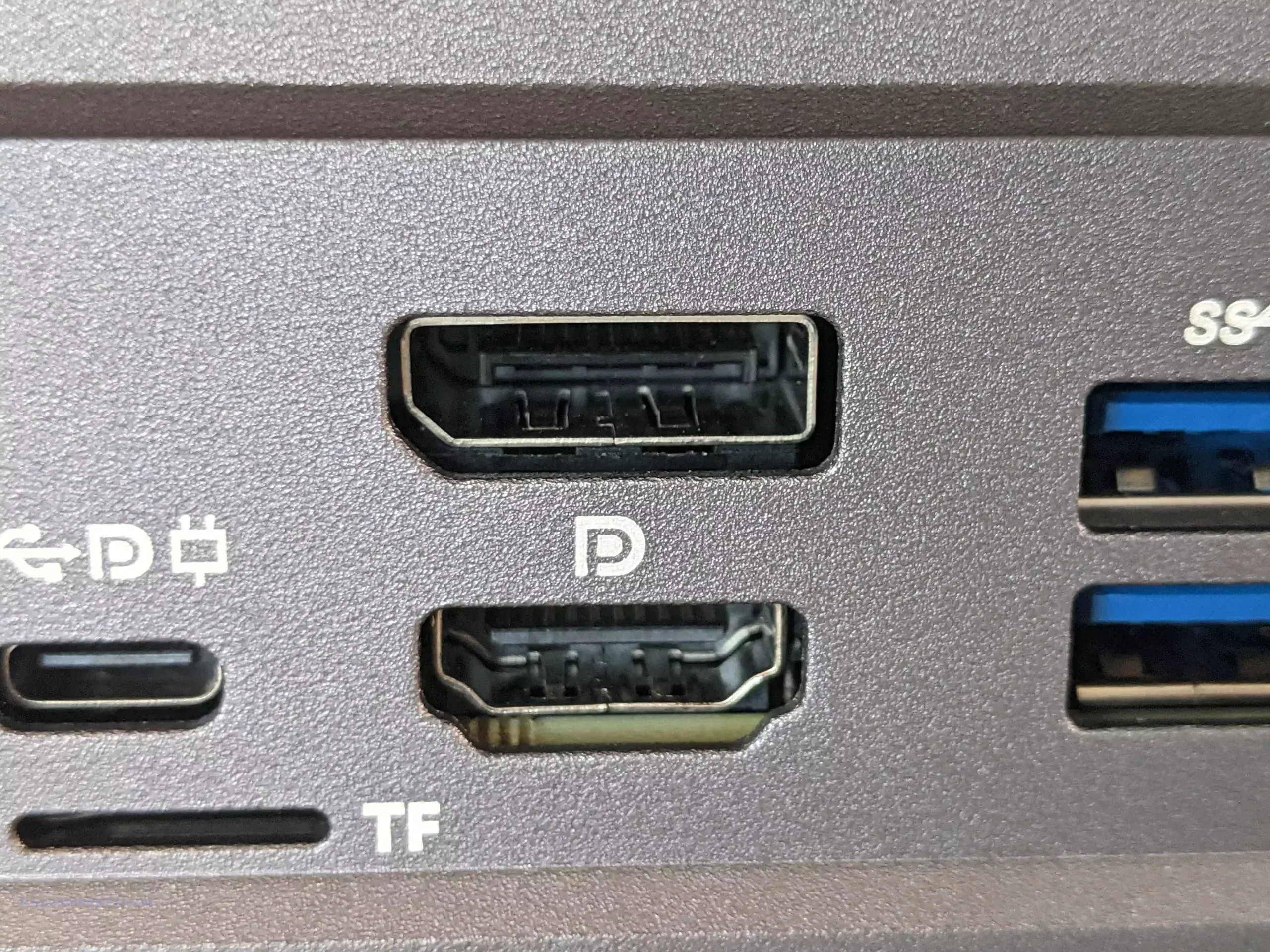
There is an HDMI 2.1 output and a DisplayPort as well, which depending on the NAS operating system you are going to install, will provide a wide variety of visual outputs and direct KVM access via the numerous USB ports.
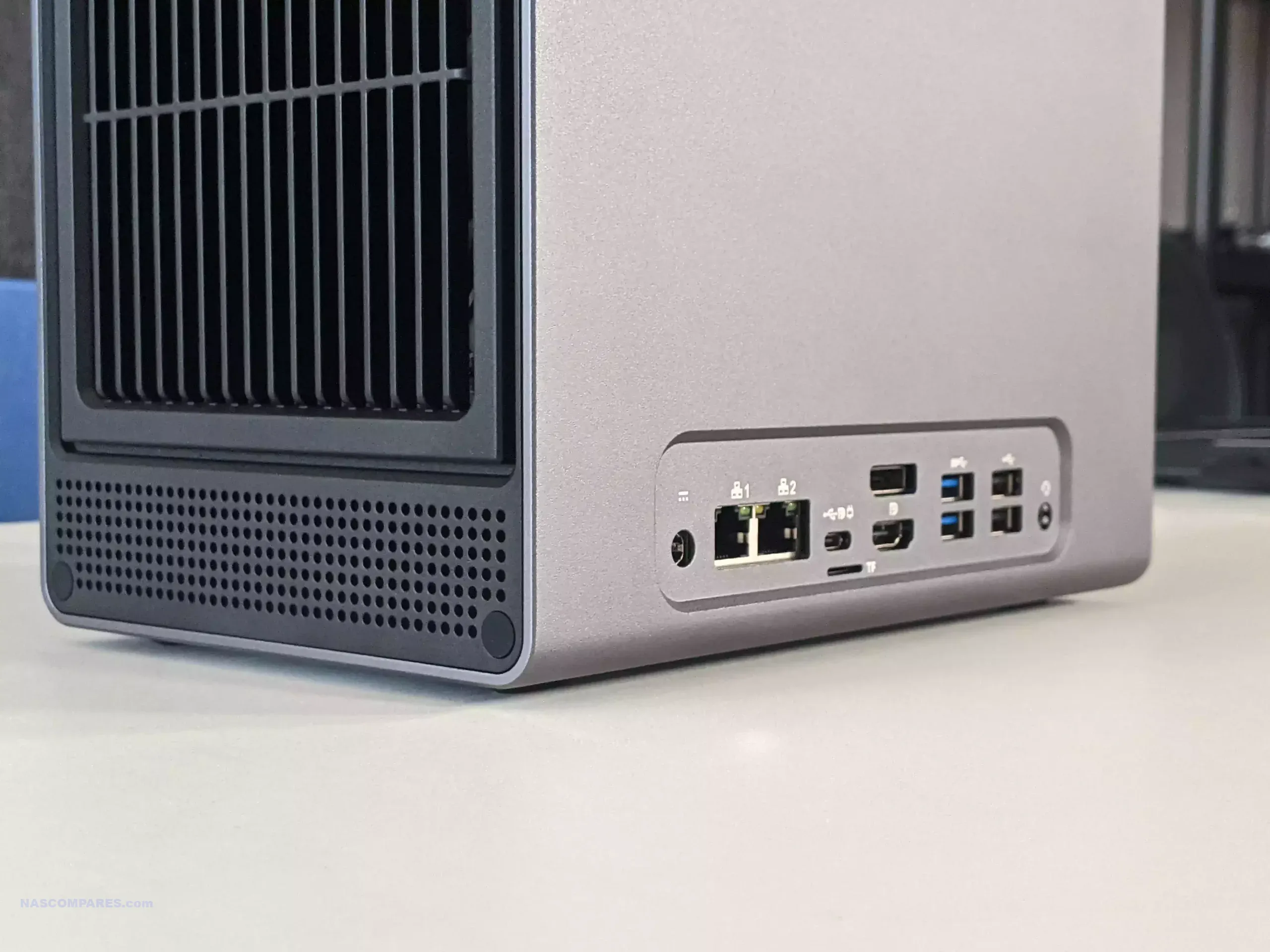
Uniquely placed, actually a little boring, and surprisingly underwhelming for a system that arrives with quite a beefy CPU under the bonnet. The lack of ability to directly upgrade the network connectivity to 10GbE or higher via a PCIe upgrade slot or a USB 4/OCuLink port is also a little bit disappointing. Let’s talk a little bit more about the internal hardware.
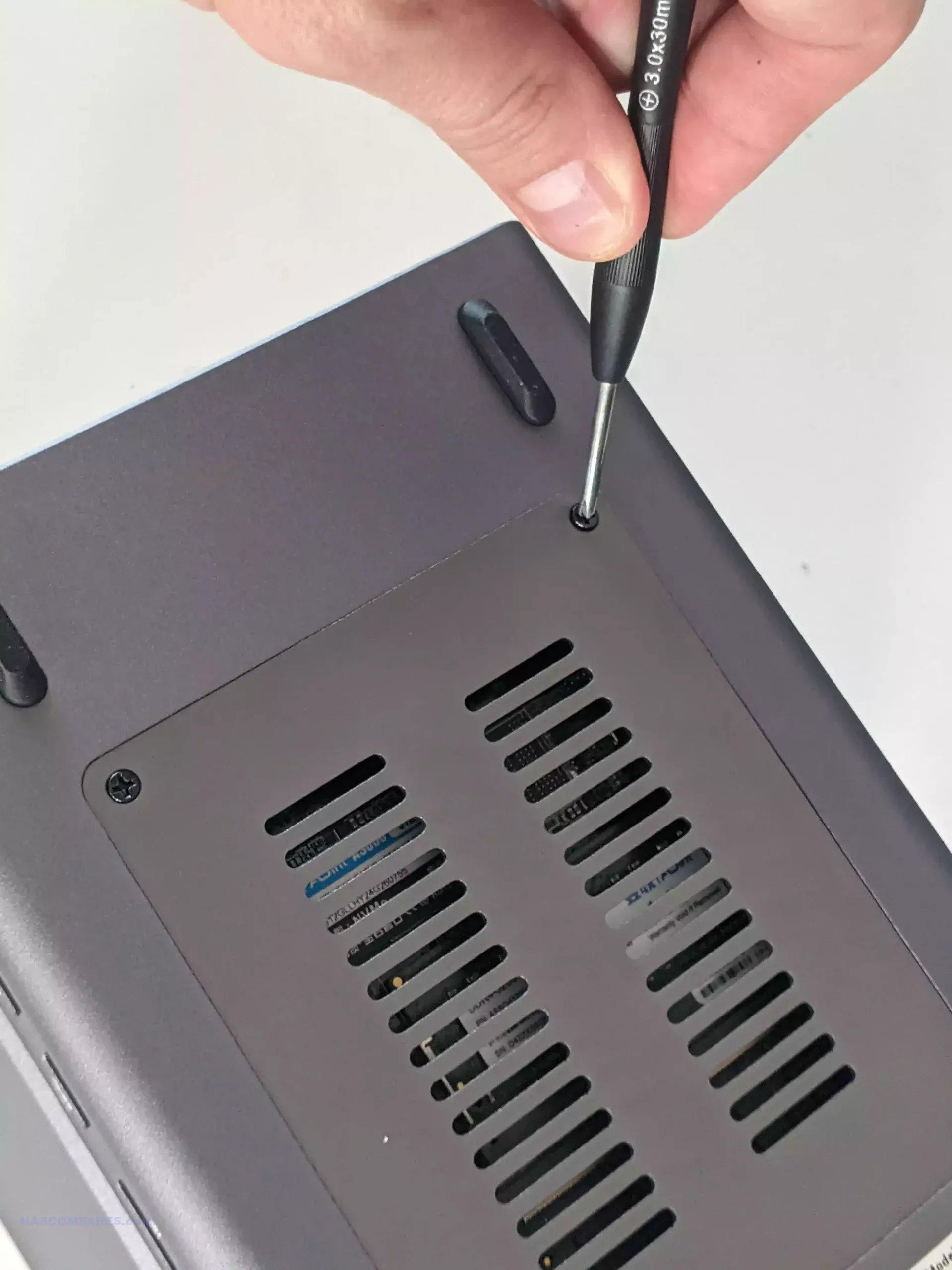
Aoostar WTR Pro NAS Review – Internal Hardware
The Aoostar WTR arrives in two very distinct configurations when it comes to internal hardware. The more affordable option is the N100 quad-core, four-thread processor system that arrives with a single M.2 upgrade slot internally. However, the far more powerful and performance-ready option is the AMD Ryzen 7 powered system, arriving at around $100 to $200 more depending on where you shop. This more powerful option arrives with an eight-core, 16-thread processor that features integrated Radeon graphics, and 16 lanes of Gen 3 architecture to neatly spread out across the system.
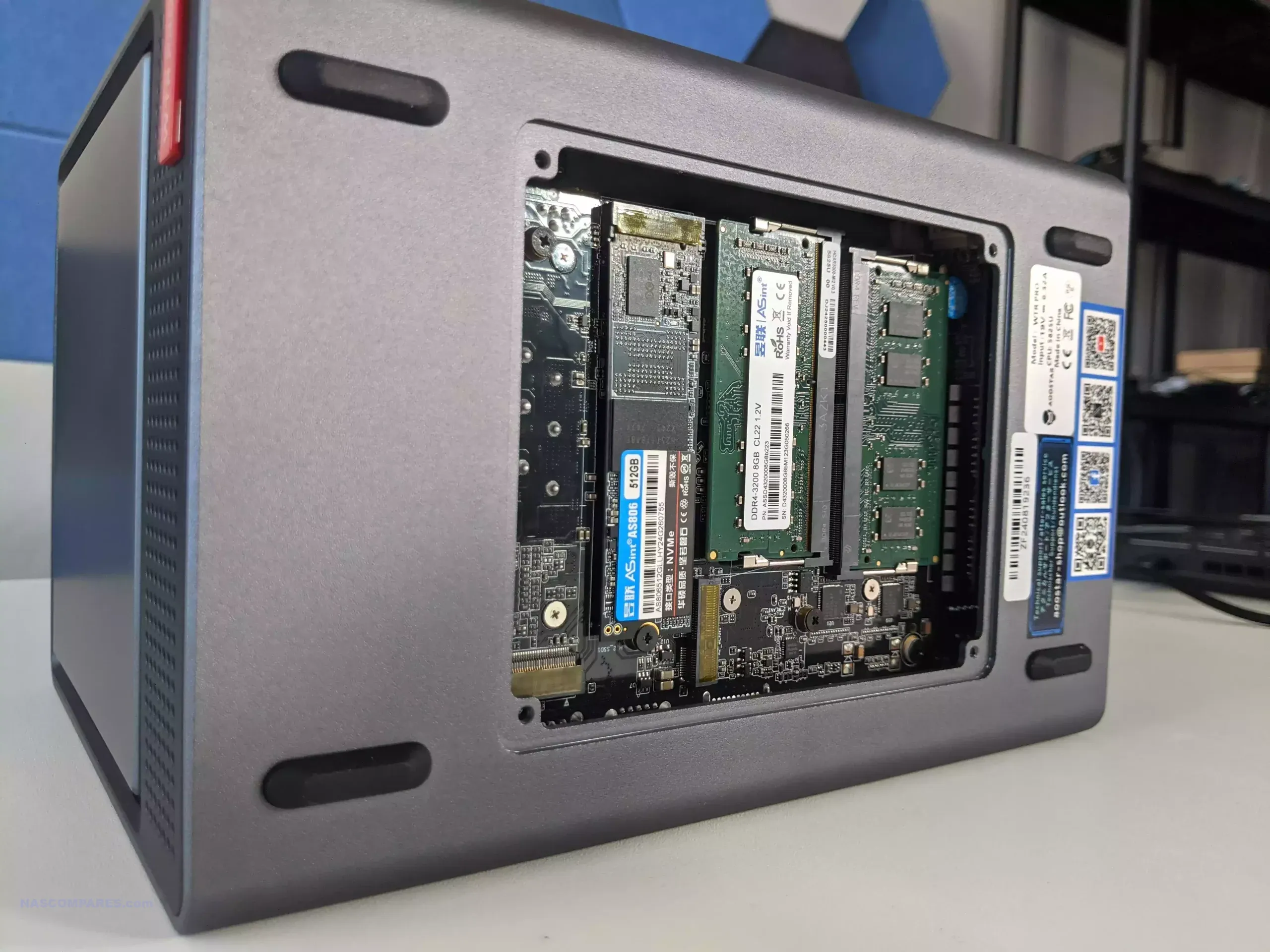
At the base of the system, there are two NVMe SSD M.2 slots that are Gen 3 x4 speed each. These slots can be utilized for caching within the storage system or storage pools for hot data as required and do not need to both be populated to be used.
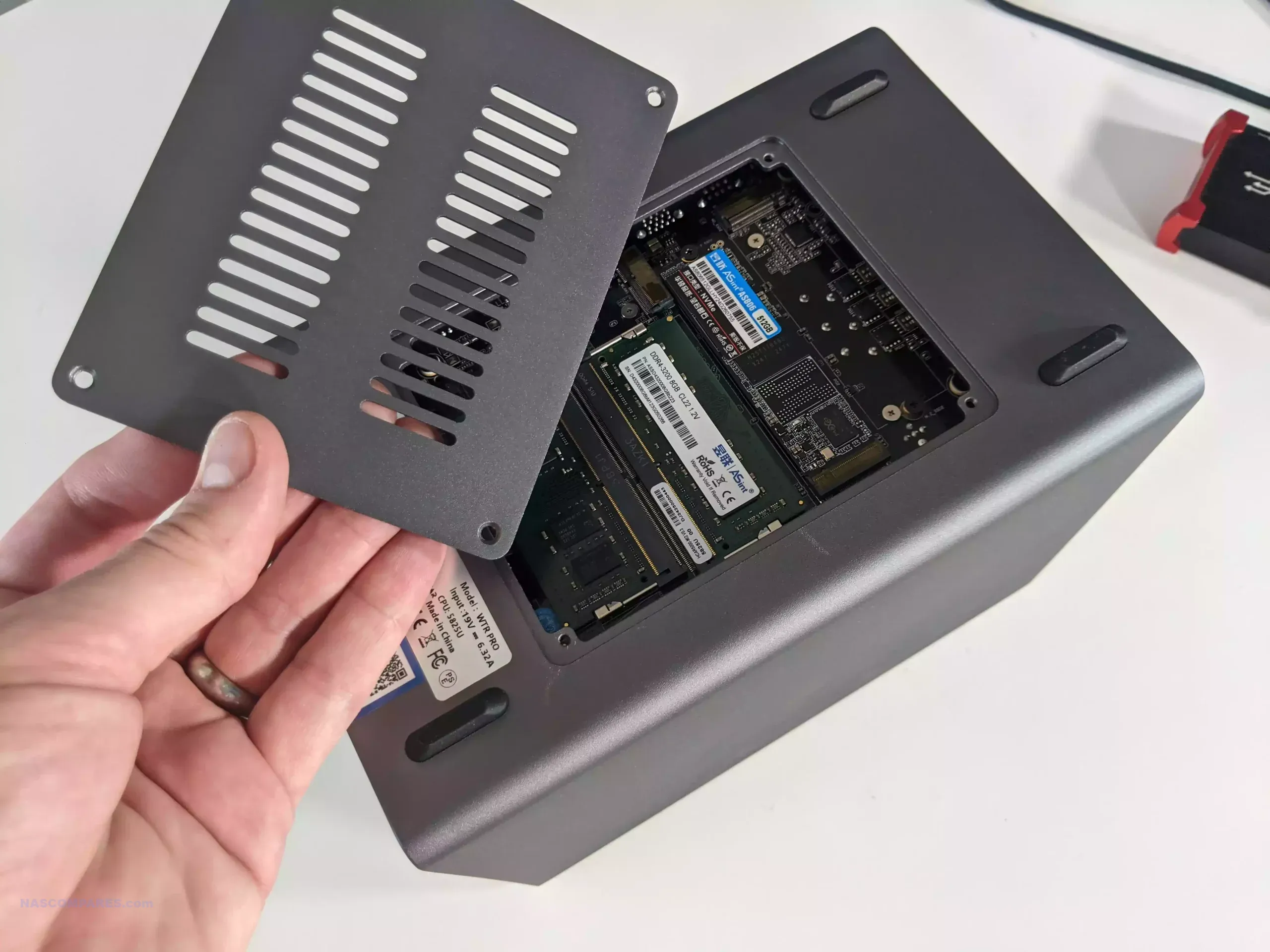
There isn’t a tremendous amount of space afforded to these SSD slots, but there is definitely enough room for a slim heatsink or thicker thermal pads to directly connect with the heat-dissipating metal panel that lives over this bay. It’s a clean and simple arrangement and is quite standard for 4-bay systems.
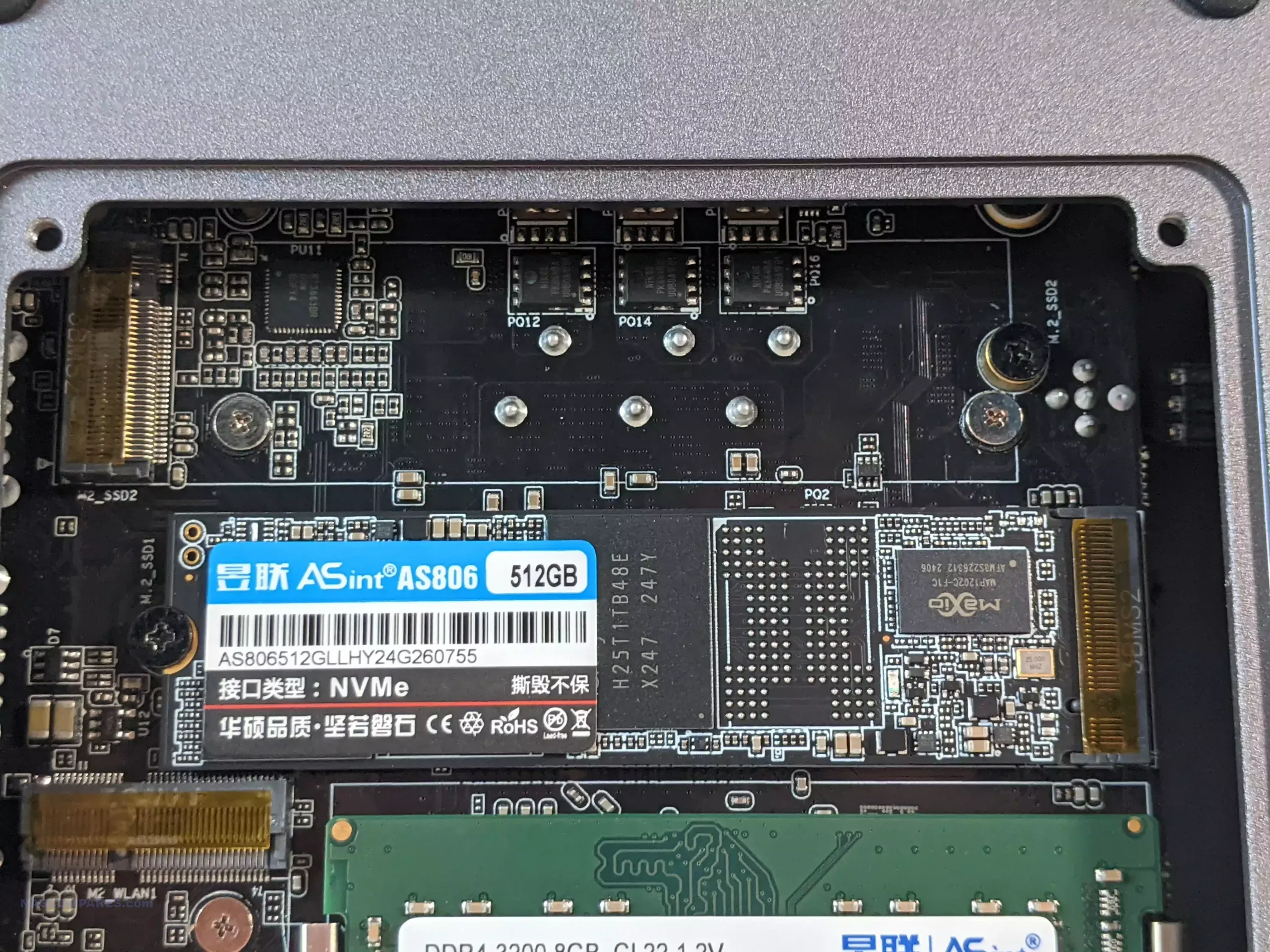
Each M.2 slot supports a 2280-length SSD, but do keep in mind that there are no screw holes for shorter-length 2242 or 2230 SSDs. This is by no means a deal breaker and frankly, you get poorer price per terabyte on these drives, but just keep that in mind in case you have an old SSD lying around that you want to reuse in this system.
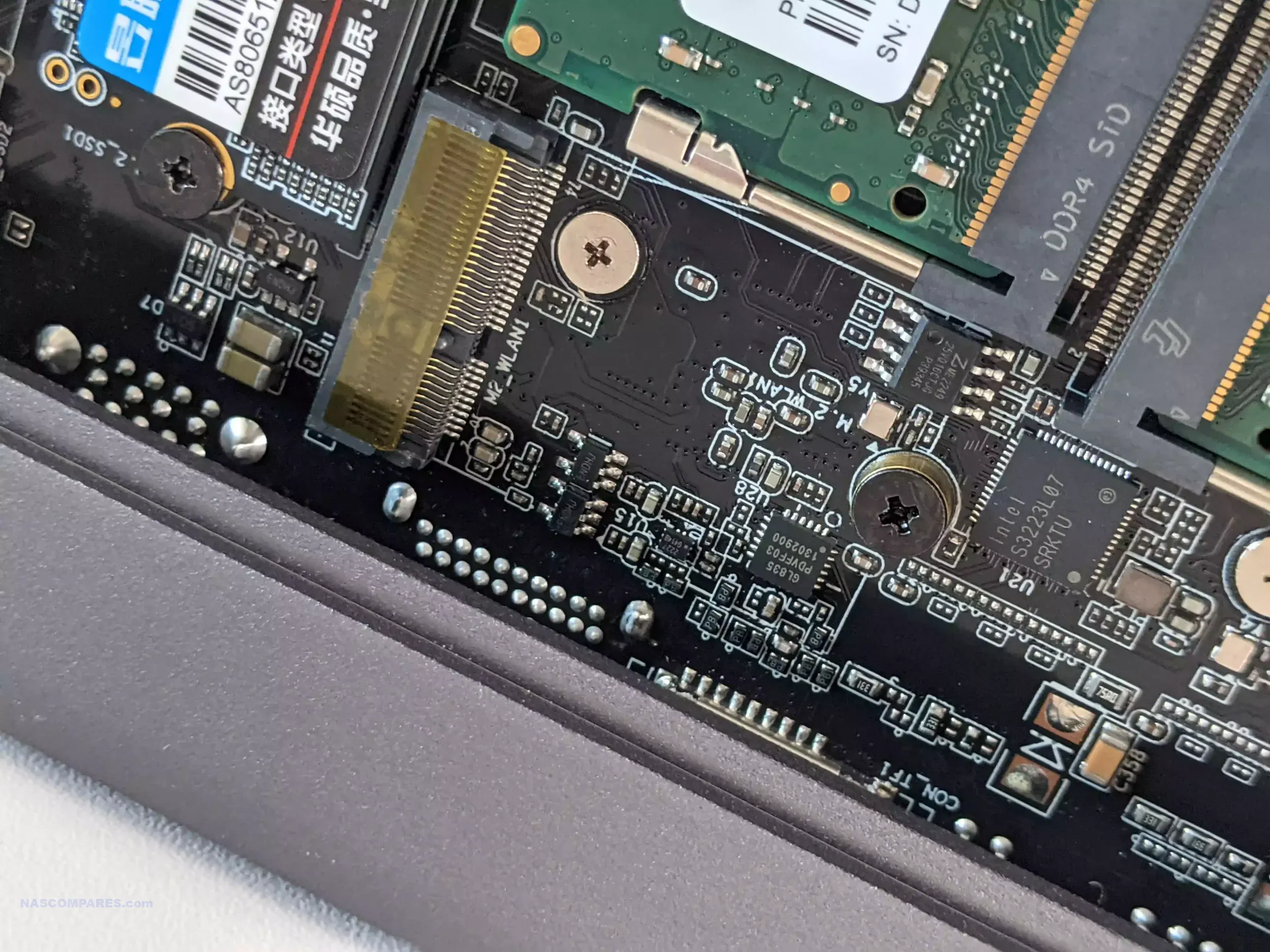
Additionally, there is a smaller M.2 slot for a Wi-Fi adapter. I’m kind of surprised that this doesn’t come with Wi-Fi out of the box, but as this is hardly a heavily-used form of connectivity for most users, I’m prepared to let that slide, and the fact that they provide the slot regardless is a useful little addition. Nonetheless, I’m sure there would have been a way to utilize this slot for a smaller OS drive for installing TrueNAS, etc. That would have freed up all of the available M.2 slots for pure NAS storage, rather than potentially losing one for the operating system drive.
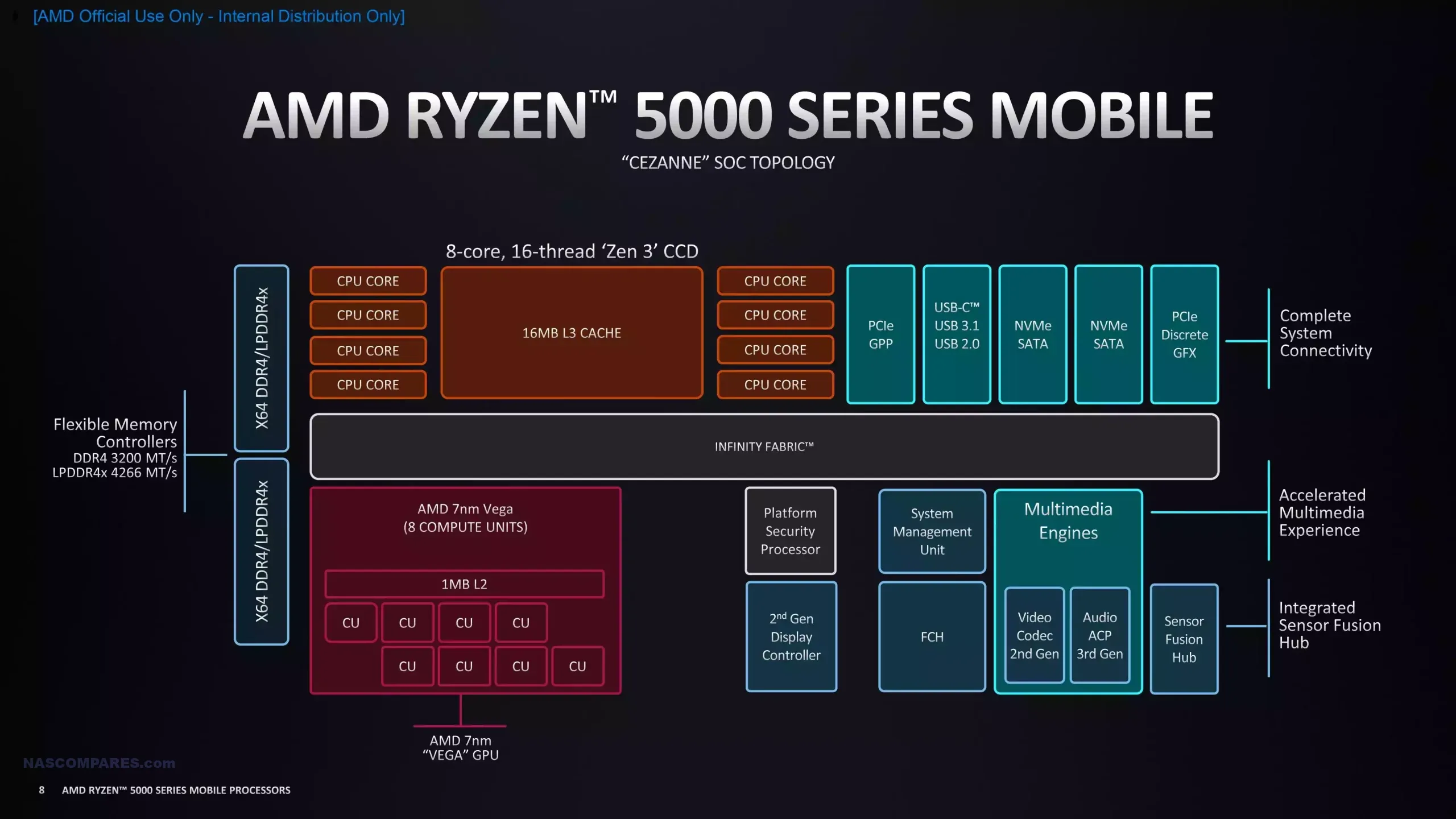
The Aoostar WTR Pro NAS offers two distinct CPU options, catering to different user needs and budgets. The AMD Ryzen 7 5825U configuration is the more powerful choice, featuring an 8-core, 16-thread processor with a boost clock of up to 4.5GHz. This CPU is not only designed for high-efficiency performance in multitasking and data-heavy applications, but it also comes with integrated AMD Radeon graphics, which significantly enhances its capabilities for handling visual tasks such as 4K media streaming and light graphical rendering. The 16 PCIe Gen 3 lanes provided by the Ryzen 7 allow for ample bandwidth distribution between the M.2 NVMe slots, SATA bays, and other system components, ensuring that the storage and data processing capabilities are fully optimized. This makes the Ryzen 7 model ideal for power users who need a NAS that can handle more demanding workloads, such as virtual machines, AI-driven applications, or multimedia editing.
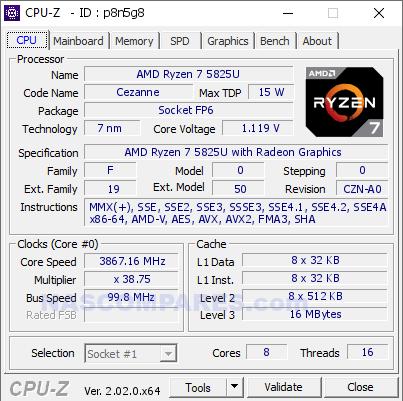
The Intel N100 version, while more budget-friendly, is still a strong contender for users with lighter performance needs. This quad-core, four-thread CPU runs at speeds up to 3.4GHz, and though it is less powerful than the Ryzen 7, it still offers sufficient performance for common NAS tasks like file sharing, backups, and moderate media streaming. The N100 includes integrated Intel UHD Graphics, which can support up to 4K display output, making it capable of handling multimedia streaming without any issues. However, the PCIe lane allocation in the N100 configuration is more modest, offering fewer lanes than the Ryzen 7 setup, which slightly limits expansion and data throughput for tasks involving multiple high-speed storage devices. While it doesn’t match the powerhouse performance of the Ryzen 7, the N100 model provides excellent value for users seeking a reliable and affordable NAS solution for everyday tasks without the need for intensive graphical or processing power.
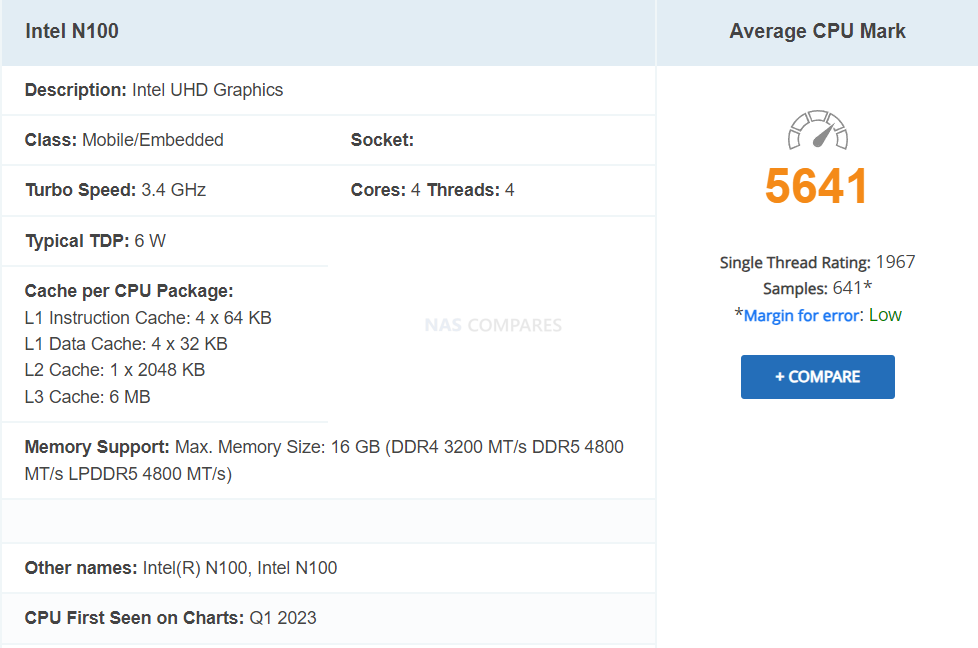
Also found inside this base panel are the two SODIMM memory slots that support DDR5 memory. The 32GB option arrives with two 16GB DDR5 non-ECC memory modules. This CPU does not support ECC, so don’t waste your time putting ECC memory in here, which solves half the problem. The maximum memory you can install is 32GB.
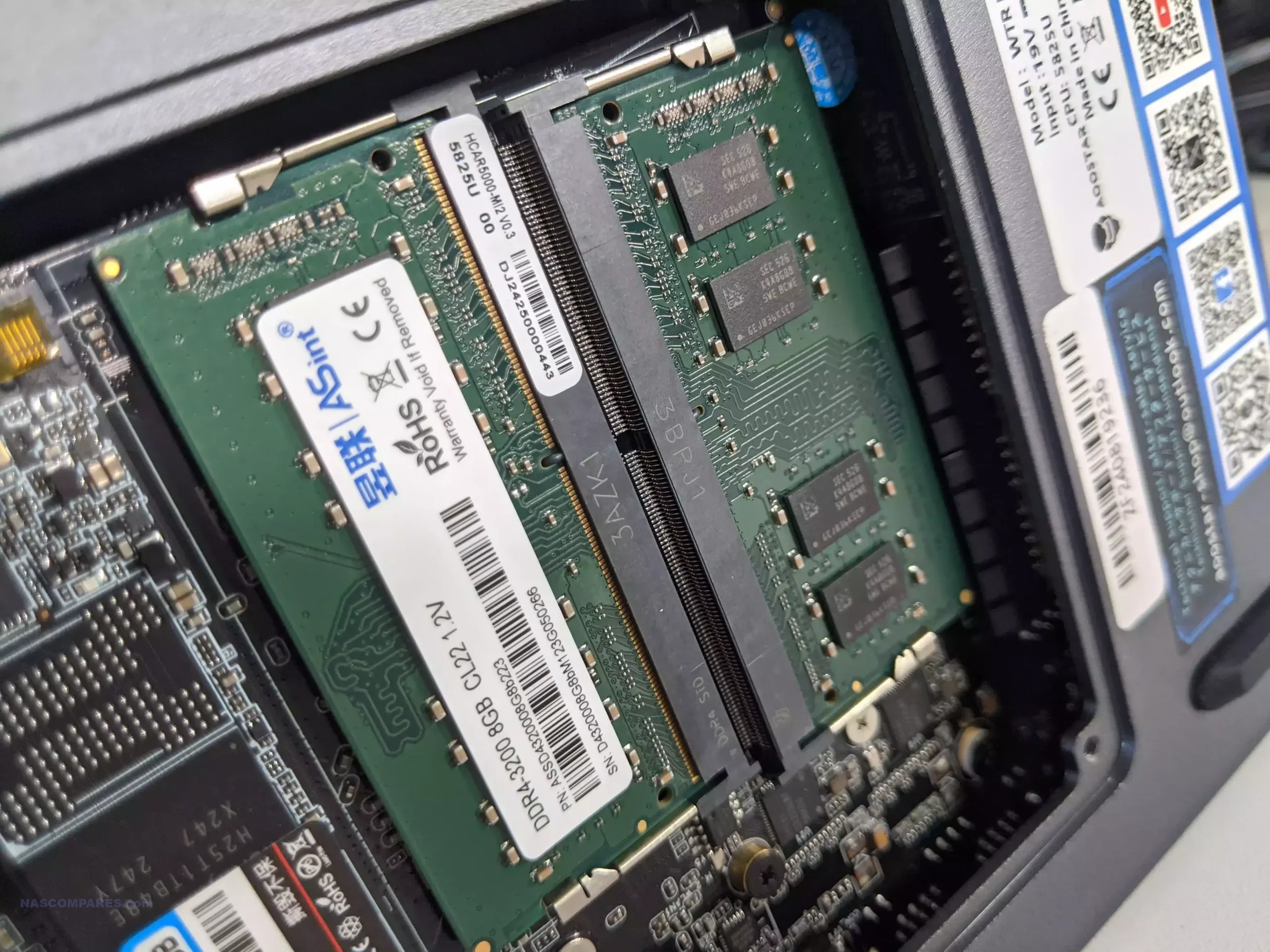
Weirdly, despite the more premium and capable CPU inside this model, I’m actually the tiniest bit underwhelmed by the hardware here. Having two NVMe slots for speed is definitely great for hot-tiered storage, and 32GB of memory is nothing to sniff at! Additionally, the power consumption for the device is…reasonable. It is not low, but given the hardware architecture across the 6 bays, the Ryzen 7 processor and cooling, its acceptable in both idle and active power consumption. We saw an average of 21-24W when the drives and system were in Idle, and 64-66W when all drives were accessed and the CPU was at 40-50% use.

However, I really do feel that this architecture internally could have been expanded toward a PCIe upgrade slot or maybe even onboard 10GbE. I completely understand the lack of ECC memory, as ECC-ready processors and motherboards would have increased the price considerably for more than what Aoostar is trying to do here. But the hardware is not the best thing that Aoostar has ever put out, and although I am sure it will run the majority of software in the market beautifully, this hardware does seem to have scalability limitations.
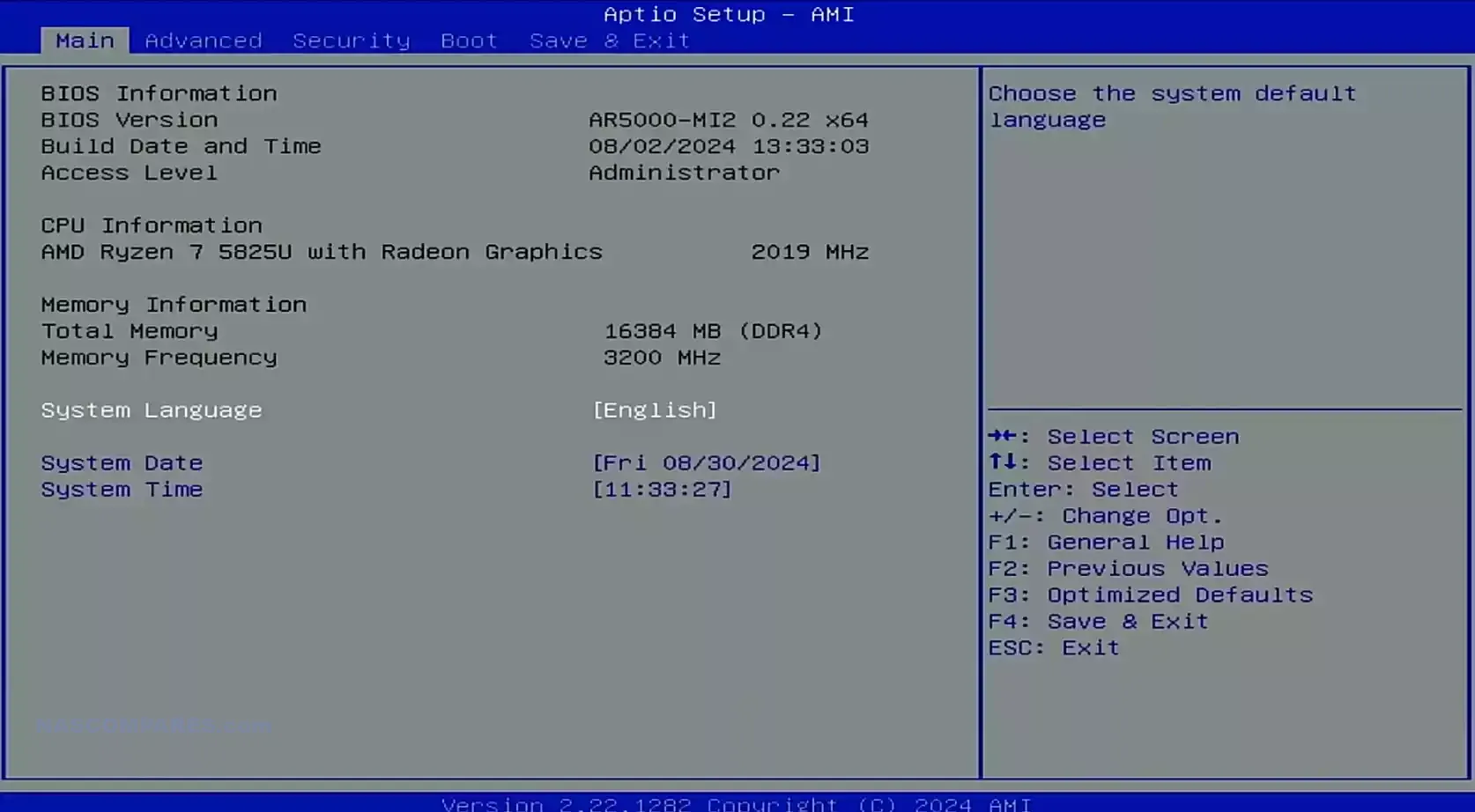
Aoostar WTR Pro NAS Review – Performance
Benchmarking the external performance of the WTR Pro was kind of unnecessary. As the system only arrives with dual 2.5GbE network connectivity, this presented an immediate bottleneck regardless of whether I was testing the four SATA drives internally or taking advantage of storage pools on the M.2 NVMes. Populating all four bays with Seagate IronWolf 4TB NAS hard drives and placing them in a one-disk redundancy ZFS array in UnRAID, unsurprisingly, fully saturated the 279 MB per second possible on a single connection and almost fully saturated both ports once I connected them via aggregation. This was a sustained performance number that did not dip even after 15 minutes of continuous AJA testing at a 1GB file size. I did not even bother testing the external performance of the M.2 storage bays via this limited external connectivity.
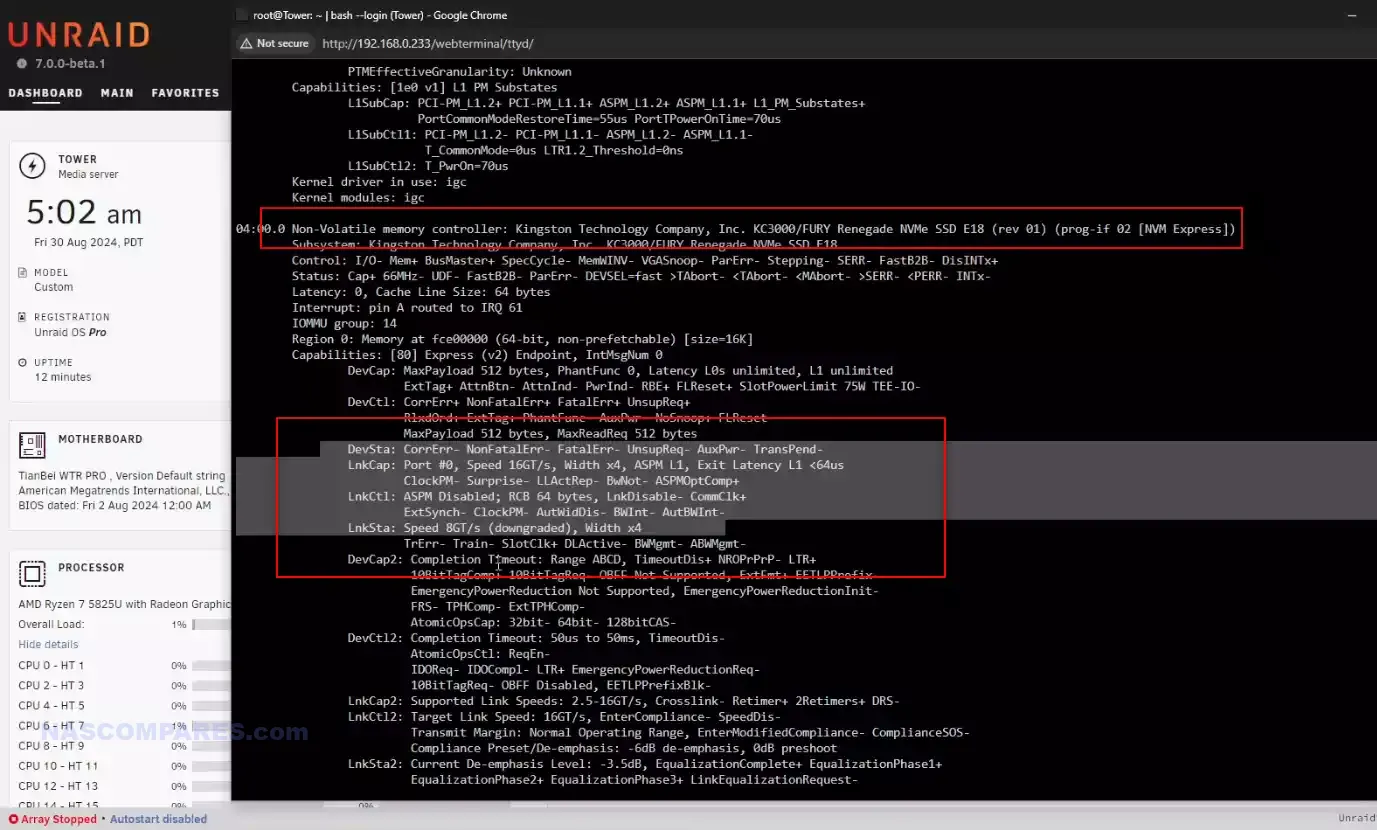
However, I was able to use the SSH terminal in UnRAID and measure the performance of the M.2 SSDs internally. The write performance was a comfortable 2.6GB per second on a repeated 1GB file test without caching, with the read performance regularly exceeding 3GB per second. These are all positive numbers and mean that each of these slots can take advantage of Gen 3 x4 speeds as advertised.
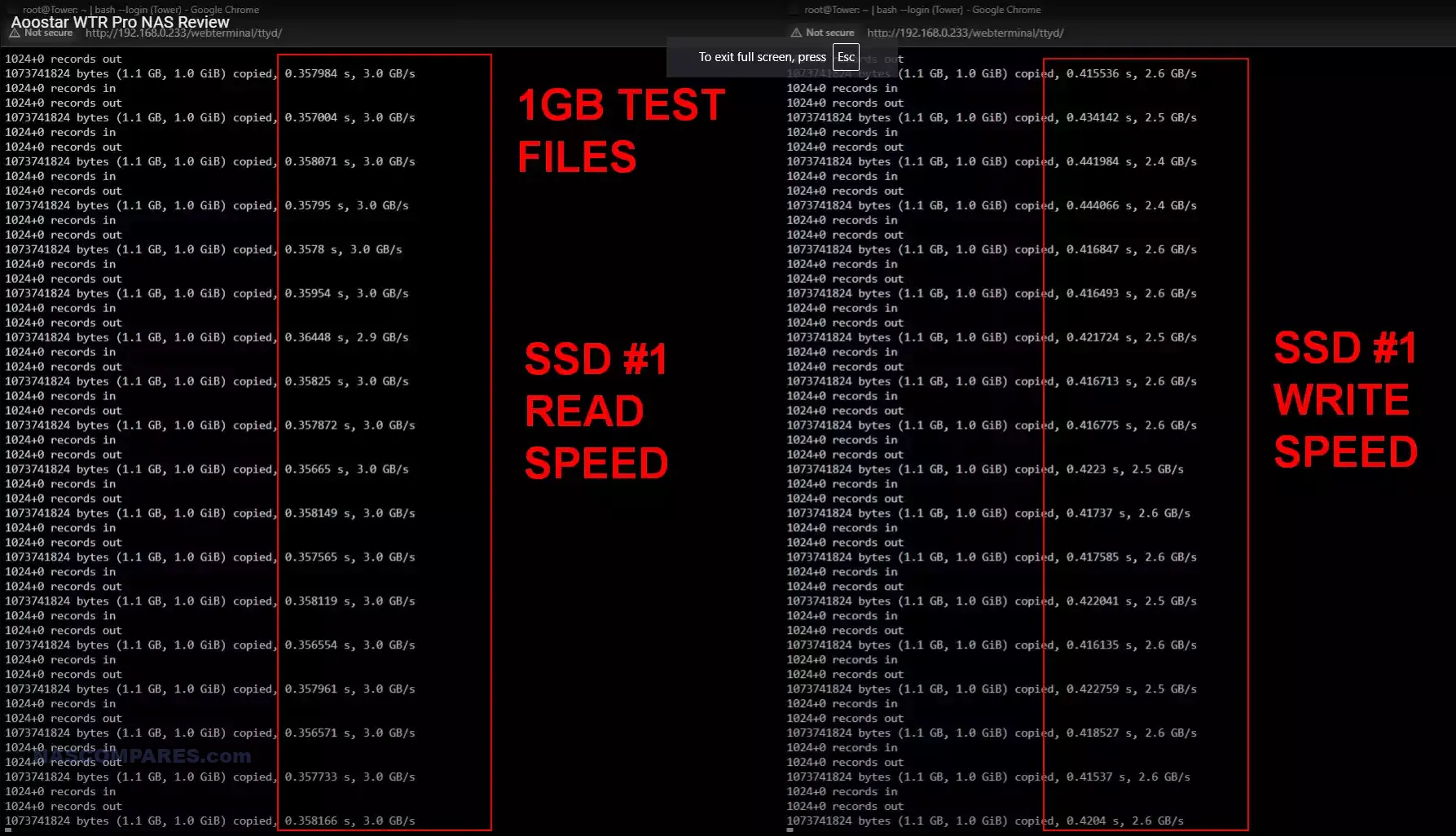
However, once I started trying to transfer data between the SSD slot in bay one with bay two, we saw drastically reduced performance as low as 560MB per second. This no doubt means there is some kind of shared internal controller that these bays are being fed into, perhaps another controller handling the SATA bays. The result is that if you are migrating data between these storage areas, there are indications of internal bottlenecks here that could reduce those transfers.
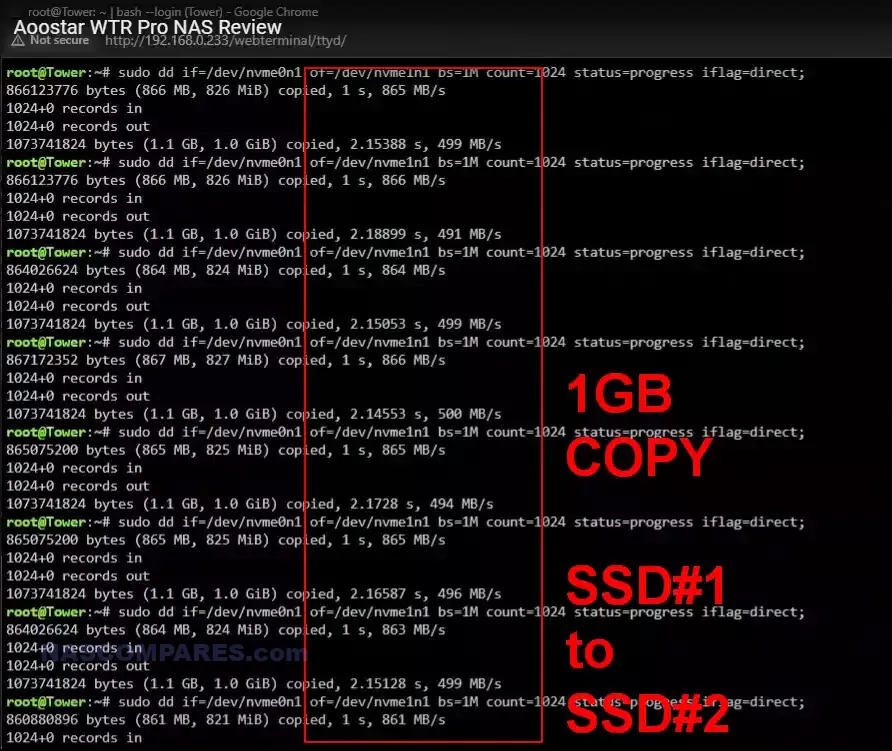
Most users won’t be hit by these bottlenecks, as most will be using these SSDs for caching, which will not present any kind of problem when migrating data away from the slower hard drives onto the faster SSDs. Indeed, even if you placed two SSDs in the slots in a RAID 1 environment that effectively mirrors them, the system’s read and write operations are done in parallel instead of from one disk to the other, which means the bottleneck will not present any kind of issue here.
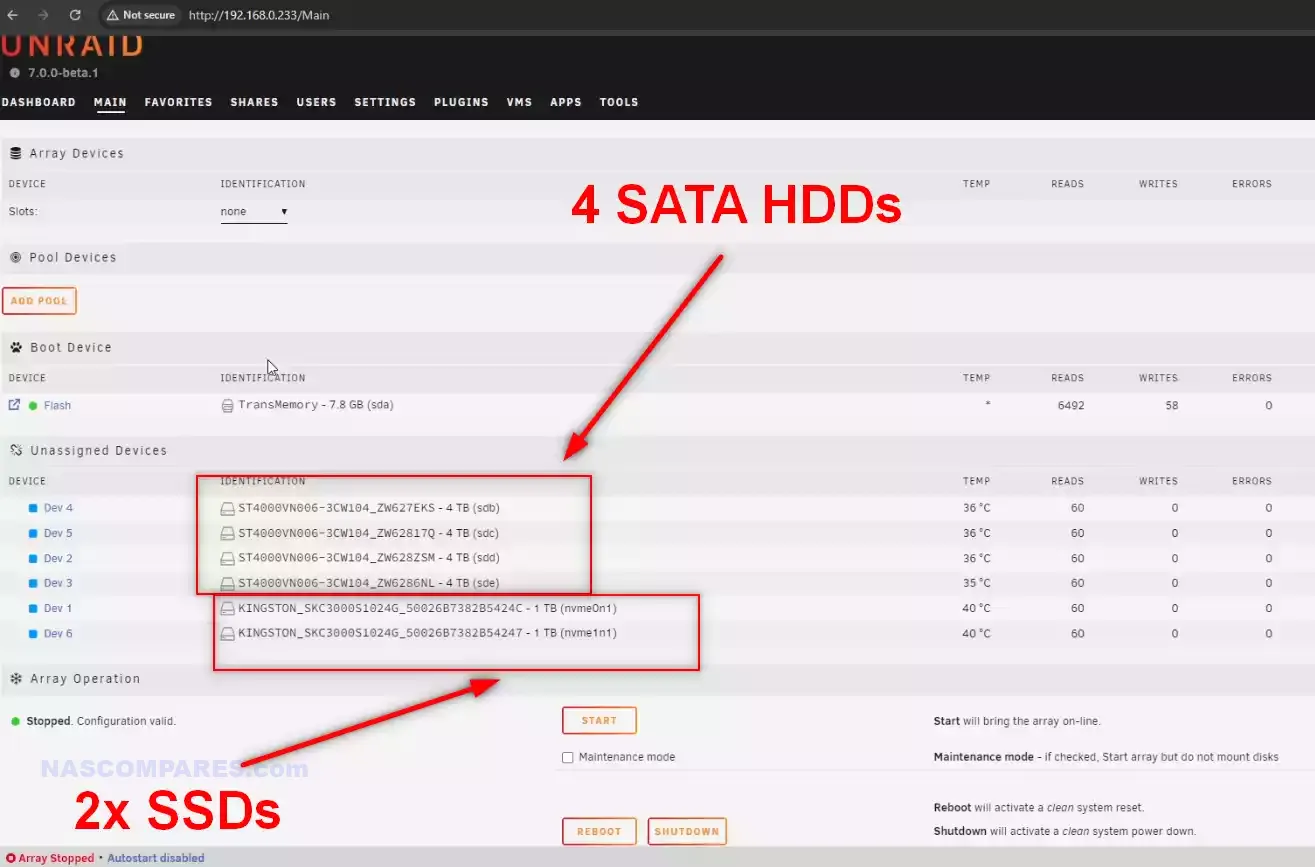
Nevertheless, there are definitely compromises that have been made here to keep this system at this price point, and although you have a decent amount of storage here, you are never really going to get to enjoy it externally. The fact that the system lacks any PCIe scalability or easy means to upgrade network interfaces beyond that of supported USB adapters, which cost extra, all adds up to a system that will give you decent performance internally but arguably lackluster performance externally.
Aoostar WTR Pro NAS Review – Conclusion and Verdict
Given the price point, there is an awful lot to like here. For under $499, you have either an eight-core AMD-powered system with 32GB of memory and a 512GB operating system SSD, or a quad-core N100 CPU version with 16GB of memory and a 128GB OS SSD for $349+. Whatever way you slice it, you are getting quite a lot for your money in this 4-bay M.2 SSD hybrid storage system compared with other turnkey NAS solutions in the market. Yes, you are getting a system that you’re going to need to factor in time and money for a third-party operating system, but a lot of users are going to enjoy that flexibility. Also, I’m quite a big fan of the unique placement of the ports on the chassis that have really grown on me throughout the testing of this system. Also, this has a weird two-slot configuration, something you don’t really see that much of.
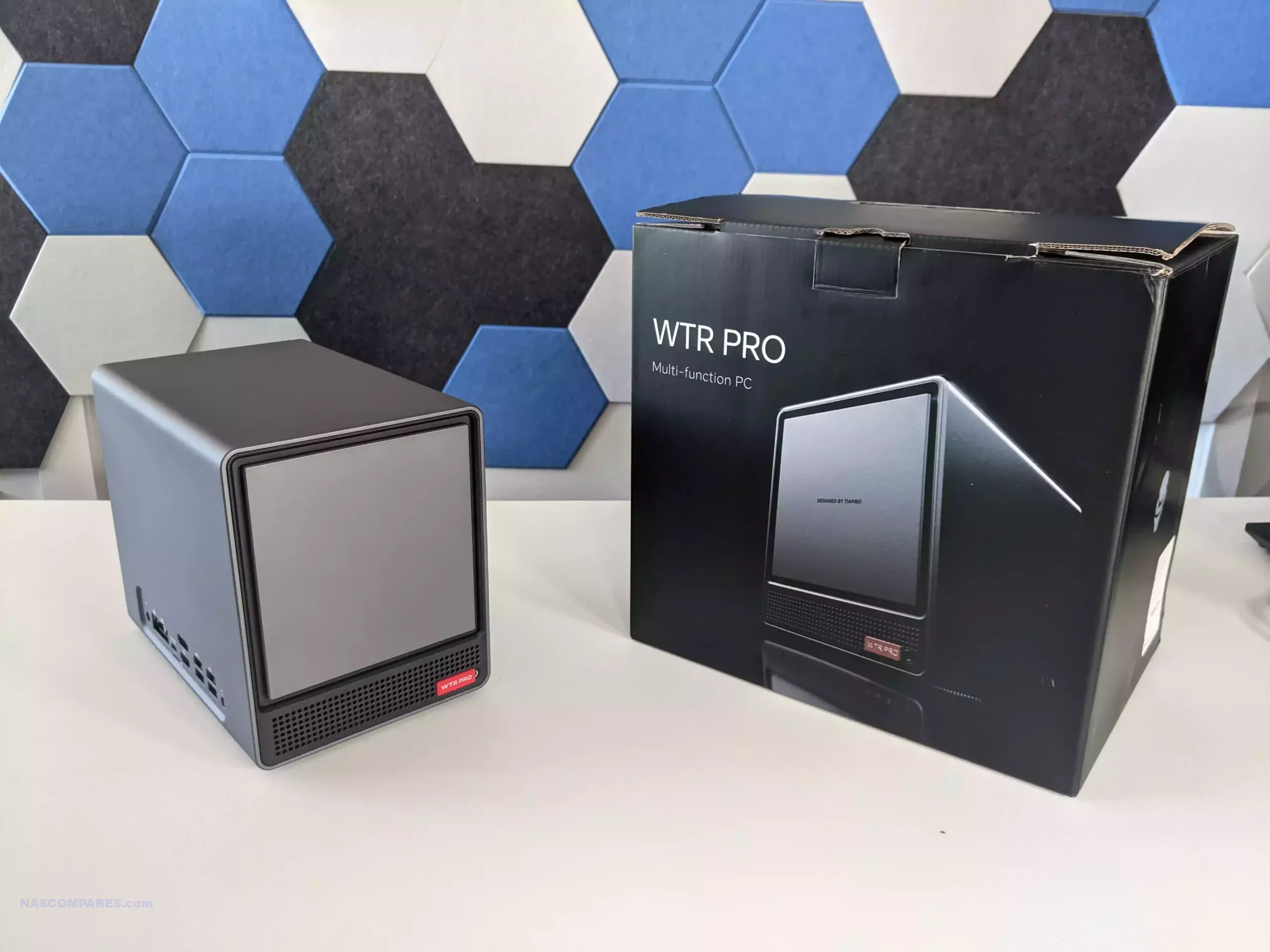
But it has to be said that all of these pros do arrive with a little bit of compromise. The fact that the system lacks any 10GbE network connectivity, or any realistic means to scale up towards it, is definitely going to be a bummer for those that want to make the most of the storage capacity and performance on offer here. The lack of USB4 connectivity and OCuLink also tremendously reduces the potential scalability of the system in other ways too. Aoostar has done a good job in the last couple of years, releasing some genuinely unique products that are seemingly all developed in-house. Clearly, they have targeted a more domestic class user with this system, so my criticisms have to scale toward this, and I can’t be too harsh for the price point. Nevertheless, this is a great little enthusiast and prosumer NAS system that, unfortunately, lacks a lot of the scalability that a more industrious user is going to desire in their own private server solution. Definitely a great NAS, but not one that is going to blow you away like some of their other solutions have done.
🔒 Join Inner Circle
Get an alert every time something gets added to this specific article!
This description contains links to Amazon. These links will take you to some of the products mentioned in today's content. As an Amazon Associate, I earn from qualifying purchases. Visit the NASCompares Deal Finder to find the best place to buy this device in your region, based on Service, Support and Reputation - Just Search for your NAS Drive in the Box Below
Need Advice on Data Storage from an Expert?
Finally, for free advice about your setup, just leave a message in the comments below here at NASCompares.com and we will get back to you. Need Help?
Where possible (and where appropriate) please provide as much information about your requirements, as then I can arrange the best answer and solution to your needs. Do not worry about your e-mail address being required, it will NOT be used in a mailing list and will NOT be used in any way other than to respond to your enquiry.
Need Help?
Where possible (and where appropriate) please provide as much information about your requirements, as then I can arrange the best answer and solution to your needs. Do not worry about your e-mail address being required, it will NOT be used in a mailing list and will NOT be used in any way other than to respond to your enquiry.

|
 |
(Early Access) Asustor Flashstor vs Terramaster F8 SSD PLUS NAS - Best SSD NAS Drive?
(Early Access) A Guide to NAS - Things People STILL Get Wrong
(Early Access) $30 5GbE-to-USB Adapters Are a THING NOW (Wavlink Adapter Review)
(Early Access) Acasis TBU405 Pro Max TB4/USB4 NVMe Docking Station Review
(Early Access) ROUAFWIT Teknas 4 NAS - Big Budget? Or Bloody Awful?
(EARLY ACCESS) Zettlab OFFLINE AI NAS Series - The D4, D6 and D6 D8 ULTRA #ifa2024
(Early Access) Terramaster F4-424 Max Plex NAS Tests
(Early Access) Aoostar WTR Pro NAS Review
(Early Access) A Fake NUC as a Pocket Proxmox - Any Good? (GMKtec K8 NUC Mini PC)
(Early Access) UnifyDrive UT2 UT2 Portable NAS Drive Review
(Early Access) Terramaster F8 SSD PLUS PLEX NAS Tests
(Early Access) Terramaster F8 SSD PLUS NAS Review
Access content via Patreon or KO-FI


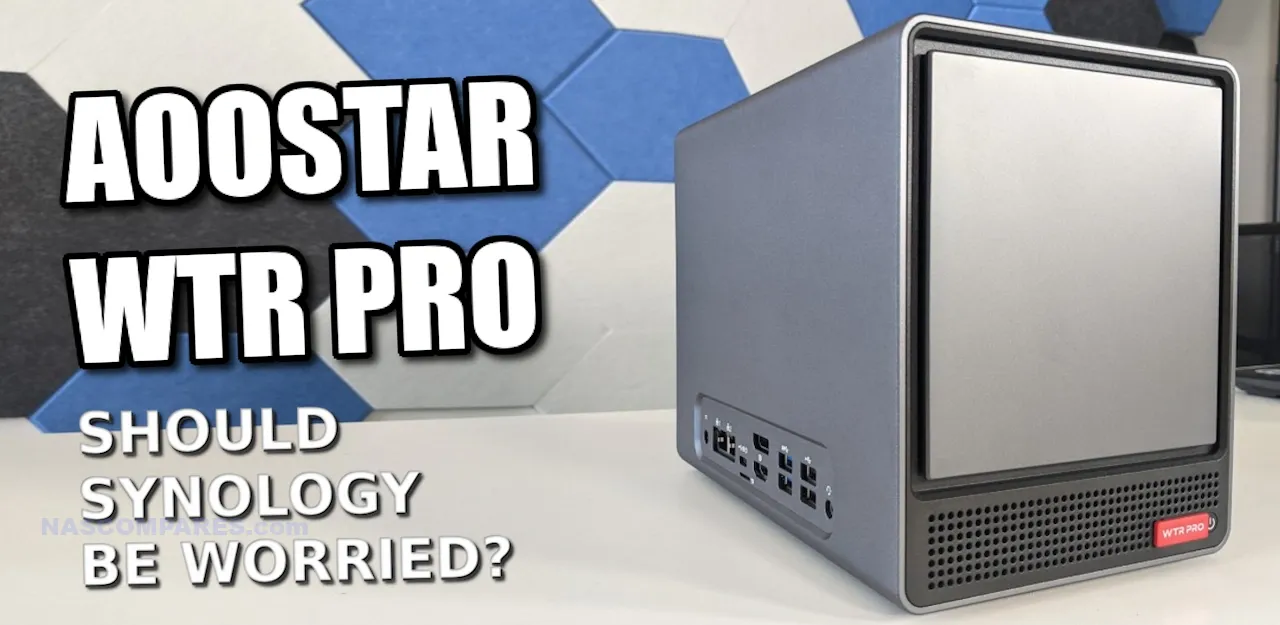





RAID 5 in such a small NAS is not a good idea. Run SnapRAID with one spare and mergerfs on top and it’s fine.
REPLY ON YOUTUBE
Me: Watches NASCompares videos.
Also me: Uses a Raspberry Pi with a handful of USB drives as his personal NAS.
Still love the channel, though.
REPLY ON YOUTUBE
It was built around the 2-bay nas board. They could only put the ports on the side in this format.
REPLY ON YOUTUBE
Please test low power s0 idle
REPLY ON YOUTUBE
Good review, i use a ryzen7-5825u model 2 weeks ago, but facing at the first day, it hasn’t good ventilation, advertised pictures with airflow are fake, it has a bad engineered cooling, because that 120mm fan push air through hdd caddy only, so cpu fan try to sucks fresh air through rear bottom small holes, in a small space, that means, cpu temp can rise easily ove 80°C. So immediately modified mine, completely disassembled, heatsink cleaned and applied MX4 thermal grease, replaced factory 120mm fan to a bigger 140mm Arctic P14 max version, dismantled original rear fan plate, drill holes to rear plastic grille, and hang fan with silicone fan mounts, lowering fan to center, so now it can push fresh air around cpu cooler and heatsink, drill 9 holes to hdd caddy bottom plate, over cpu fan to help airflow. Now i get normal cpu temp, checked with win11, i get 39°C under idle, 78 at full throttle, but set in bios “defaul 15w-> short time 35w-> long time 25W tdp”, so after 1 minute cpu temp fallen to 68°C max, and cpu power slightly less. Completely enough for a daily work, or any nas server operation system with 7-8 VMs, now cool and futureproof. I am very happy now.
REPLY ON YOUTUBE
In the webpage it says maximum 64gb, could you confirm this?
Barebone price is 380€ which I think it’s an amazing! then you can buy good components like ram and nvme drive.
REPLY ON YOUTUBE
Great informational video as usual. I just wish you would stop knocking these devices for not have 10 Gbps adapters. Most of these are consumer/prosumer devices, and in real world conditions, 2.5, and really, 1 Gbps is going to be more than sufficient. For enterprise devices, 10 Gbps and ever 40 Gbps should be standard, but for a desktop NAS, generally it is overkill.
REPLY ON YOUTUBE
still waiting for mine to show up, not too thrilled with their production/ship times on this product. 7-21 days (small print, from the day the order is fulfilled, took 30 days to fulfill my order)
REPLY ON YOUTUBE
No, keep the ports on the back, except maybe a usb. Normal people will plug in once and then not handle for years…
REPLY ON YOUTUBE
For the price, this NAS is probably the best one I’ve seen. I wish they used a newer Ryzen CPU though as I don’t think the 5000 series Ryzen CPUs are still in production. I could be wrong as the chips were released in Q1 ’22. Considering there are 6000, 7000, and now 8000 series mobile Ryzen chips in the market it seems odd to use a 4 generation old CPU.
If I’m correct, either Aoostar got their hands on a shipment sitting in a warehouse for cheap or they’re recovering the CPUs from old laptops. If the latter, that would worry me that there is thermal damage to the CPU.
Either way for the price, I’m very interested.
REPLY ON YOUTUBE
Miller Elizabeth Davis Charles Smith Edward
REPLY ON YOUTUBE
I got the impression from this video that the drives are hot-swappable. Yet their website disclaims “The drives are not hot-swappable so you must power the machine down if you want to add or remove a drive”. Could you please clarify?
REPLY ON YOUTUBE
Did you investigate the SATA controller? The controller on the Aoostar R1 unit doesn’t support hot-swap. Honestly, livable, but it’s worth noting if these rapid-swap bays are backed by chips that actually support hot-swap.
REPLY ON YOUTUBE
Beware the build quailty may vary, I guess problem of the small company(more like studio), lots of people already point out the HDD tray problem.
Lacking 10Gb NIC because it was build for the N100 model(their best selling model), the AMD one more like a after thought.
Still I won’t consider any of these, for me extenal PSU for NAS is a big No.
REPLY ON YOUTUBE
Look like the Mainboard is Just Exactly as the one inside R7, which has a 2 bay sata and all the other ports. Also that particular MB has another Port hidden inside to connect a second Backplane or something to arrange more sata Disks. Take both appart, and you’ll see the similarities.
REPLY ON YOUTUBE
Respect for review, but I disagree, this is probably one of the best Home lab, NAS device for an affordable price. I cannot be positive about the quality of the electronics, the test of time will tell
REPLY ON YOUTUBE
One could argue that that is the back if the case and everything else comes in from the side the Logo seems to me to be on the front of the device
REPLY ON YOUTUBE
This model surprises me ; however, it needs to come in something like a 6 disk variant for me to consider. The brand also has a 3 NVME drive model too; Specwise, the 4 bay seems like a good model for doing something like running Proxmox on.
REPLY ON YOUTUBE
This is sweet!!!
REPLY ON YOUTUBE
Are there any news regarding their 8-bay WTR Pro being announced long ago. If I remember right, that supposed to have 10GB Lan.
REPLY ON YOUTUBE
This would suit my needs quite well.
REPLY ON YOUTUBE
Just curious if you’ve heard of the case headlined in this video? The JMCD 12S4 – https://youtu.be/egGvm30hjDQ?si=akPzOsb0HCM2Oh6C
It only appears to be on TaoBao, but it is pretty interesting for sure. I’d love to see you get one in and build in it.
REPLY ON YOUTUBE
Chinese junk
REPLY ON YOUTUBE
Is it compatible with xpenology?
REPLY ON YOUTUBE
man. that would make a pretty good Steam Machine for last gen games
REPLY ON YOUTUBE
Mine arrives next week, n100 seemed like a better box for my plex setup. Glad to see it featured here as there was almost nothing out there about this. I had a gem 10 before this and loved it. AOOSTAR seems to be a decent quality Chinese brand
REPLY ON YOUTUBE
Where is the Plex Test? its should be a must if a NAS comes with a new CPU 🙂
REPLY ON YOUTUBE
Dude do you live in Brighton or what. Watching your channel for more than a year not a single minute of silence thanks to seagulls ????
REPLY ON YOUTUBE
Bloody heck, better specced than Synology! What a surprise!
REPLY ON YOUTUBE
Seems pretty cool at the price point and the Watts. If they’re targeting retail punters then they won’t expect 10g and may not even have a switch with 2.5g or aggregation. Though conversely they might not know what to do with an o/s free NAS. Perhaps their home market matches that slightly odd customer more, and they’ve loads more 2.5g switches to buy.
It’s interesting/weird that the ryzen cpu is suffering the same bottleneck on drive to drive transfers that we’ve seen on N100 NAS and mini pcs. Unless it’s a bios flaw and the o/s is working through the bios due to UEFI. Hmm.
The idle watts is better than some N100 nas motherboards, especially when they’re hampered by JMB chips, or weak bios support. I wonder how the AOOSTAR with N100 does…?
REPLY ON YOUTUBE
@NASCompares does this 25 Watts idle was measured with HDD disk spin on or off?
REPLY ON YOUTUBE
I’ve just come from a review of the new Terramaster 8 nvme mini nas. 10 gbe BUT nvme are Gen 3 x 1! Doh! Homer Headslap Doh!
Now this. 2.5 gbe, but nvme gen 3 x 4. Again Homer Headslap! At this point these mfrs are doing burlesque, teasing us with ooh look I took off my scarf, what’s next boys? What’s next is we are tired of this shite
Three years later, my OWC 4m2 with 4 nvmes and about 1500 mbs transfer rate and a Mac mini with TB and a 10gbe TB adapter is cheaper, faster, and you got an actual computer, FOR FREE!
REPLY ON YOUTUBE
the I/O is identical to the R1/R7 maybe they recycle te motherboard?
REPLY ON YOUTUBE
i have a n100 two bay for emu. good stuff
REPLY ON YOUTUBE
Seems to be DDR4 not DDR5 you seemed to mix that up a few times
REPLY ON YOUTUBE
Hate them but dont eat them ????
REPLY ON YOUTUBE
I do not think you have much to complaint about using this system.
Yes, 10GBe would be nice but I do believe at that price-point it is fair enough for most intended users.
BTW, I do wonder about the fan at the back, is it pushing air out or pulling air in?
If pulling air in, where’s the dust-filter?
Ports on the side is okay if you tuk this machine underneath your TV/audio-stand but I would still prefer ports on the back and front.
REPLY ON YOUTUBE
Cheap?
REPLY ON YOUTUBE
Nice timing ,mine turned up today !
REPLY ON YOUTUBE
4:00 imo the cables are on the ‘side’ so the case can be rotated 90 degrees on a shelf for more airflow(?)
REPLY ON YOUTUBE
There are alot back story and secret on those.
The model selling in China use R7 5825U cost about $300 for bearbone.
This was half year delay from when they announced it. And the 8-bay model was canceled.
They say there will be a flag ship model. Based on their track record, we may see some design around end this year. and maybe purchaseable end next year.
REPLY ON YOUTUBE
AAAAAahhhhOOOOO (ga) *. Seriously, what’s with these brand names? Specs remind me of the Buffalo NAS’s, and the specs aren’t bad with also not bad default memory config. Looks solid middle of the road, but I’d have liked to see this come in closer to $400 retail. At the current price, it’s going to have to compete with Synology and Ugreen. And 5GbE is sort of the middle child of network interfaces – I don’t know anyone who bought into and stopped at 5GbE and you’re going to plug this into a 10GbE switch anyway. So, meh overall, and I agree with you it’s not exciting.
REPLY ON YOUTUBE
Thanks for the review!
This is a very interesting device to create a virtualization environment.
The CPU and the ability to use a lot of memory almost beg for that application.
If I didn’t already have a Proxmox server in a regular PC case, I would definitely go for this option because of the compact case and the 4 disk slots.
REPLY ON YOUTUBE
Добрый день, на салазках для жестких дисков есть рычаг (черный сапог), куда упирается жесткий диск, если его поднять и надавить на диск, то он легко извлекается.
REPLY ON YOUTUBE
Did you run unraid from the sd-card?
REPLY ON YOUTUBE
Nice review! I have recently bought an Orico HS500 Pro NAS with intel N5105. The software on its is terrible but it has standart amibios and runs casaos very well! The power consumption is lower than this and has hardware transcoding as well! I hope you review that unit soon 😀
REPLY ON YOUTUBE
Could you please review the transcoding capabilities on this AMD nas with jellyfin if possible, I always was curious how transcoding is in AMD hw. thanks
REPLY ON YOUTUBE
how many nas systems have horizontal harddrives.
REPLY ON YOUTUBE
Personally I’m against Wi-F- cards in NAS boxes. Yes it can work *but* there are so many potential issues that is it worth the support hassle? Hardwired to a switch means very little to go wrong and you get full duplex vs the shared nature of WIFi
REPLY ON YOUTUBE
Wow, this is exactly what I could buy in this price point, 200-300 cheaper than alternative, such a shame it doesn’t include 10Gb NIC
Love the design, a little bit on the fence about port location tho
REPLY ON YOUTUBE
Just want to note, in my view the “back” direction is relative. You can still consider the cable side the back. Probably that’s why they added a logo on the opposite side, which can face you.
REPLY ON YOUTUBE
Waiting for n305 version of it, thx for the great reveiw
REPLY ON YOUTUBE
Can you recomend this over the Terramaster F4-424 Pro for Unraid? My use case would be streaming 4k media via jellyfin, some home stuff docker contrainers and hosting private gameservers to friends.
REPLY ON YOUTUBE
I’m probably in the minority here, but any NAS sourced in that country I stay way from. Don’t trust them. As far as Synology goes they only have themselves to fear as they did what the competition could not do… destroy from within…
REPLY ON YOUTUBE
This is exactly what I was looking for to replace my current unRAID hardware. i5-8600T is a bit long in the tooth, this more than doubles the performance and is a much much much smaller footprint. Ordered one today.
REPLY ON YOUTUBE
I’m still waiting for their nvme nas…
REPLY ON YOUTUBE
Also the price of the Ryzen 7 is $389.00 only barebone which is a really good price
Hi I am seeing that this NAS is able to run with up to 64GB not only 32GB as I can see in AOOSTAR website, could you maybe confirm?